

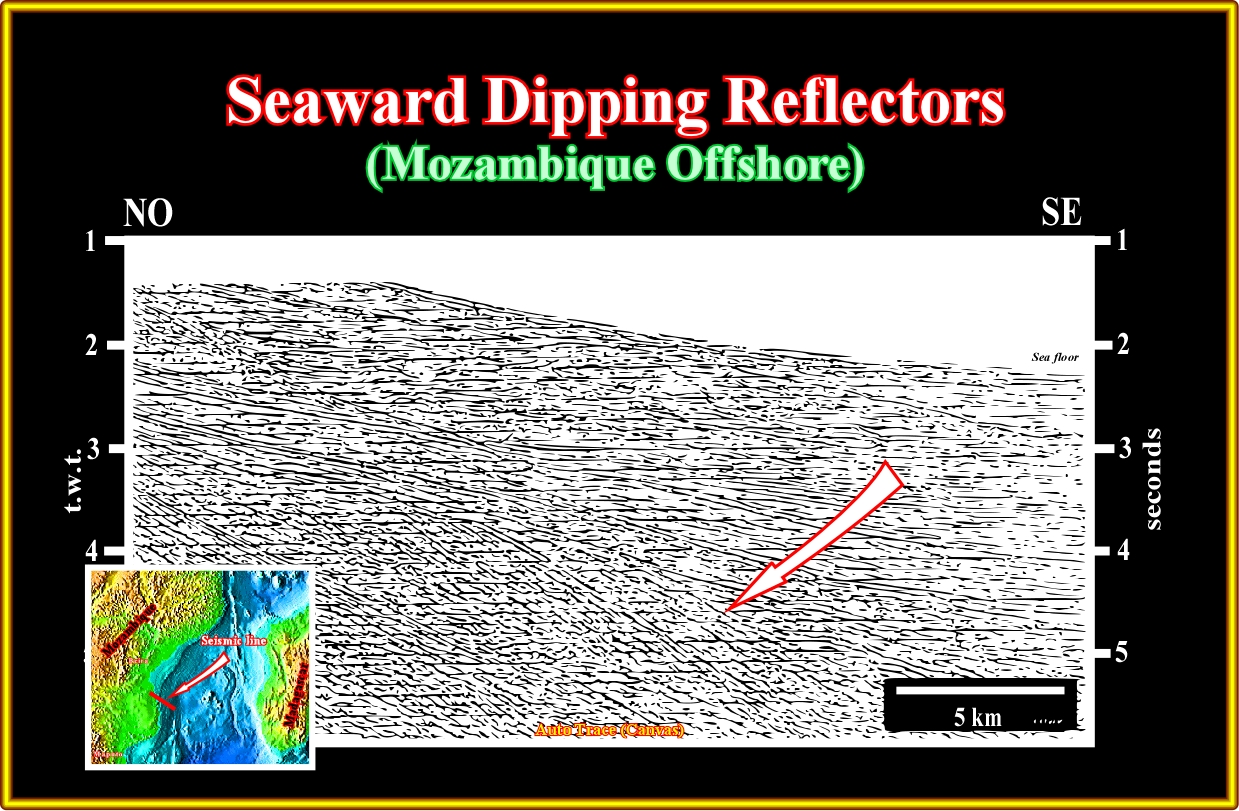
Plate A50.01- On this seismic line of Mozambique offshore, which location is quite approximative, the probability of presence of SDRs (seaward dipping reflectors interpreted has subaerial lava flows postdating the breakup of the supercontinent Gondwana) is very high, as suggested in the tentative interpretation illustrated in next plate.
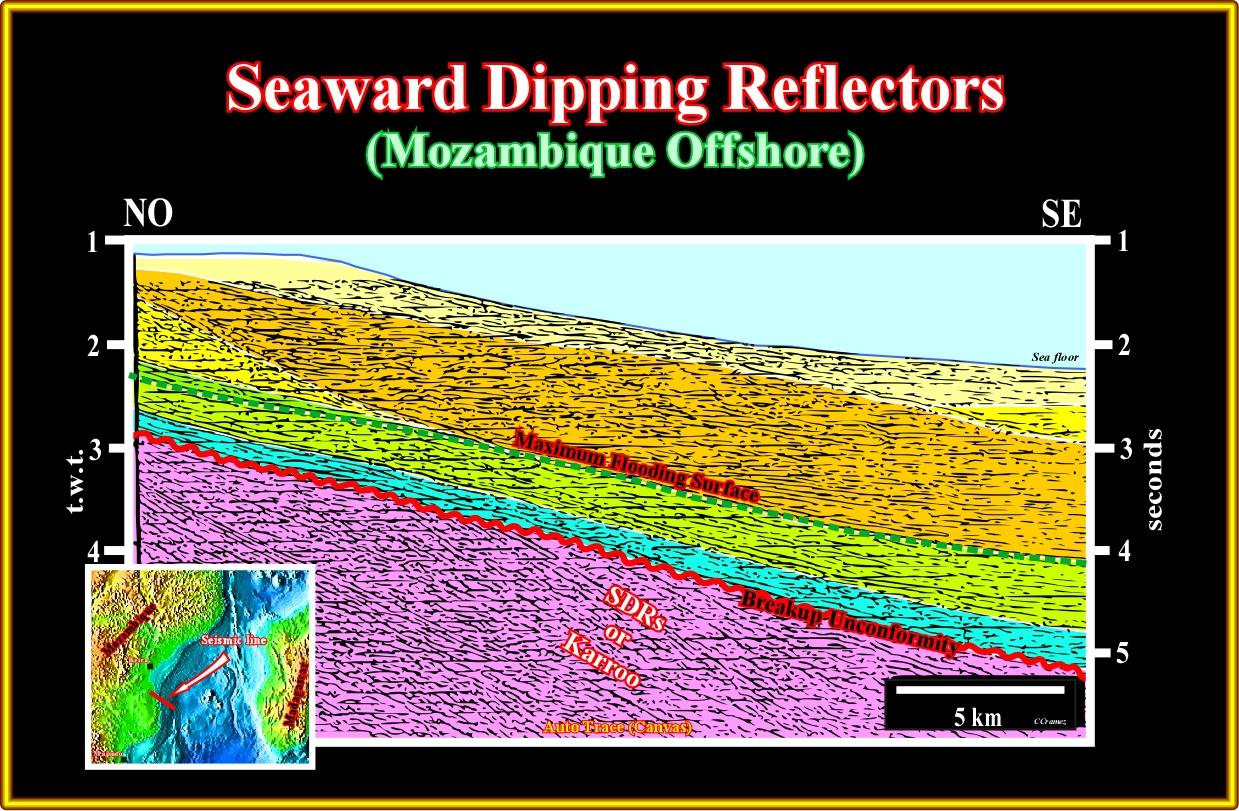
Plate A50.02- Below the breakup unconformity, the seaward dipping reflectors, which probably underline subaerial lava flows, are easily recognized. However, the possibility of Karoo sediments cannot be exclude, particularly in the lower left corner of the . Above the breakup unconformity, the transgressive phase of the post-Pangea continental encroachment cycle is characterized by an aggradational backstepping geometry, while the regressive phase is recognized readily by its progradational geometry. The maximum flooding surface between these two stratigraphic phases is obvious. Potential marine source-rocks are often associated with such a downlap surface.
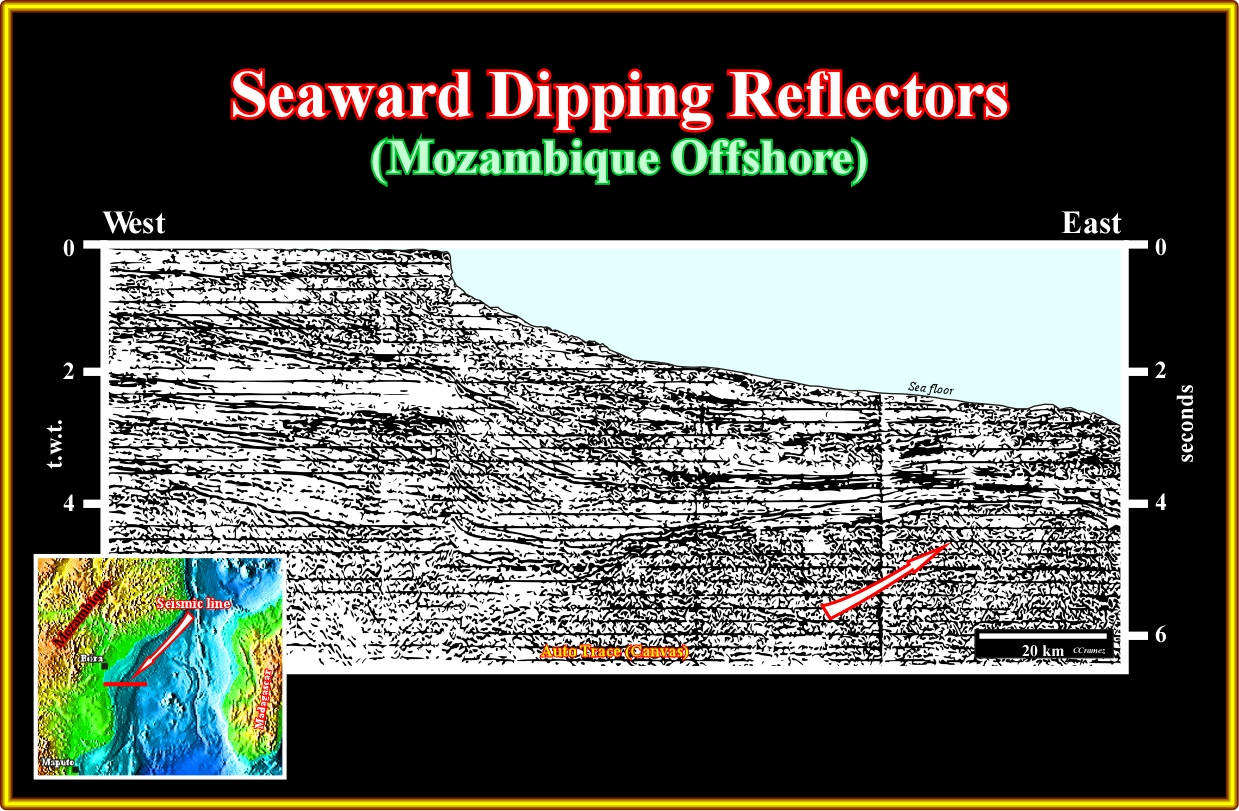
Plate A50.03- On this regional seismic line, it is likely that the geologic feature, in the lower eastern part of the line, corresponds to several wedges of seaward dipping reflectors, which can corresponds to subaerial lava flows postdating the breakup of the Gondwana lithosphere, on which the lower margins sediments onlap as suggested in the tentative interpretation illustrated next.

Plate A50.04- First of all, in the central and eastern part of this seismic line, one must take into account the pitfall induced by the sharp change in the water depth (seismic waves travel slower in the water column than in margin sediments). After the breakup of the Pangea lithosphere (here the Gondwana continent), the continental crust (hypothetically formed mainly by Karoo sediments) was accreted by the deposition of subaerial flows, before the Cretaceous transgression induced by the eustatic sea level rise characterizing the transgressive phase of the Post-Pangea continental encroachment stratigraphic cycle. After the peak transgression, which took place at Cenomanian-Turonian time, the progradational sediments of the regressive phase of the Post-Pangea continental encroachment cycle deposited in association with the eustatic sea level fall of second (Meso-Cenozoic) 1st order eustatic cycle. Note that during the Cenozoic, the tectonic component of the accommodation (creation of space available for the sediments) is almost null. In fact, since Eocene, the geometry of the reflectors landward of the successive shelf breaks is sub-horizontal.
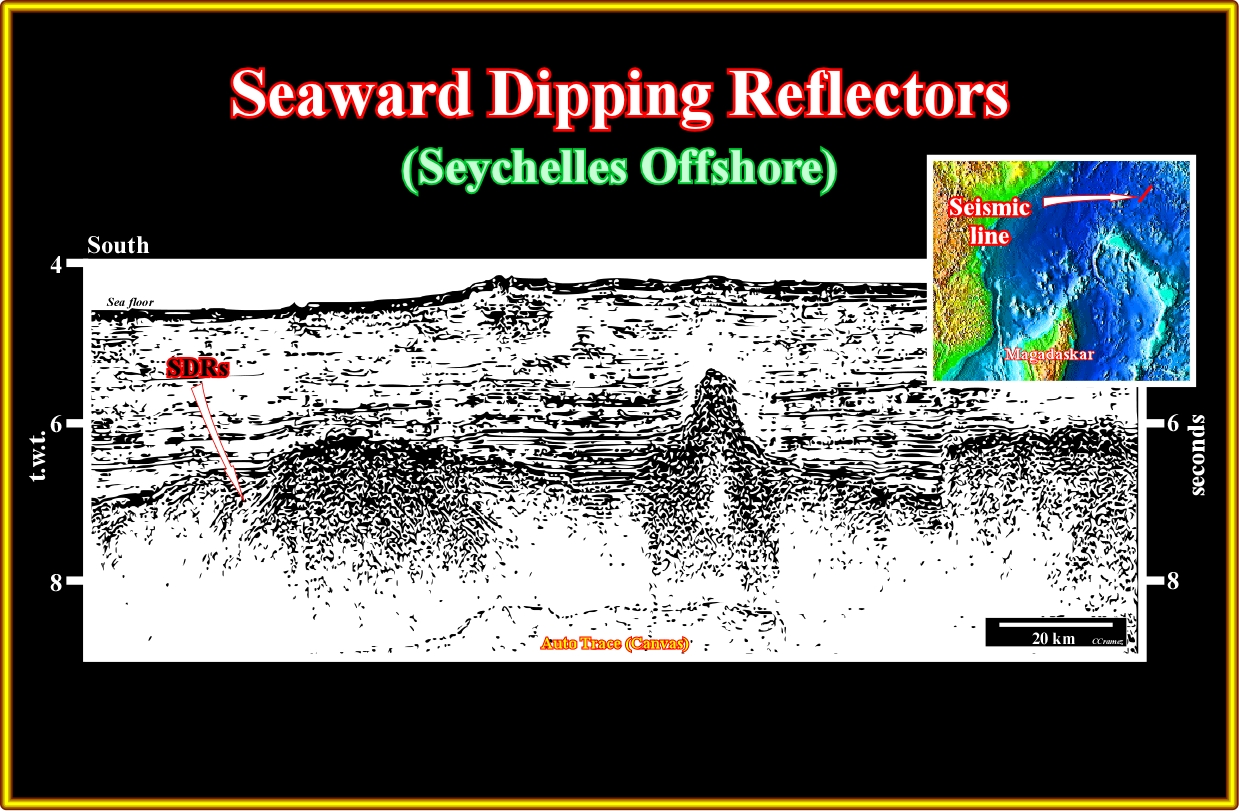
Plate A51.01- As pointed out by several India's geoscientists, SDRs (probably subaerial lava flows) and volcanic plugs are well known in Seychelles deep water offshore, as illustrated on this regional seismic line. On this line, the SDRs are dipping continentward, contrariwise to those recognized on parallel (sea next plate). The abrupt vertical displacement of the volcanic crust (subaerial or oceanic) visible in the north part of the line is probably due to the presence of a major fracture zone (a transform fault exist just between active mid-oceanic ridges).
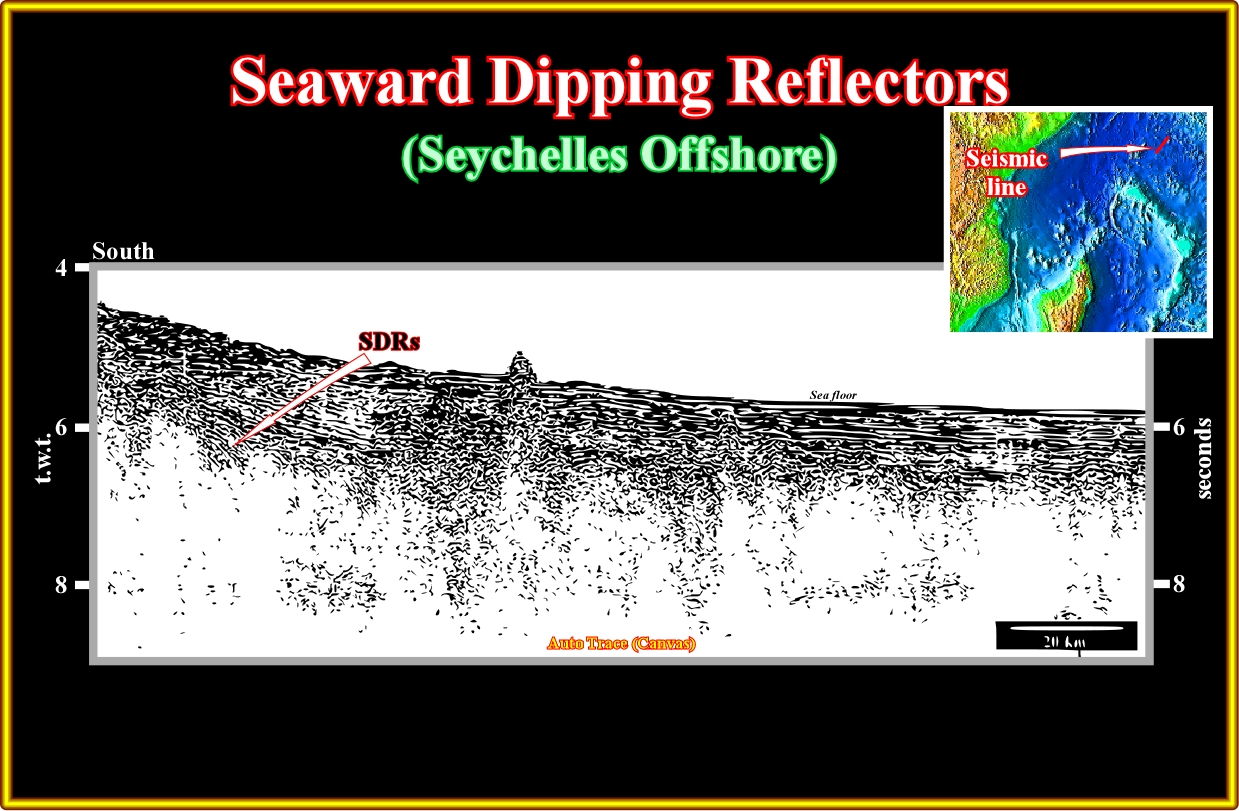
Plate A51.02- As said previously, on this seismic line, the SDRs are clearly dipping and thinning seaward, what is not the case on the previous seismic line. The more likely explanation for SDRs dipping toward the continent is the presence of major volcanic apparatus during the volcanic accretion of the margin, as suggested on the previous line, pouring volcanic material away of the volcanic crust either subaerial (conventional SDRs) either oceanic (pillow lava).
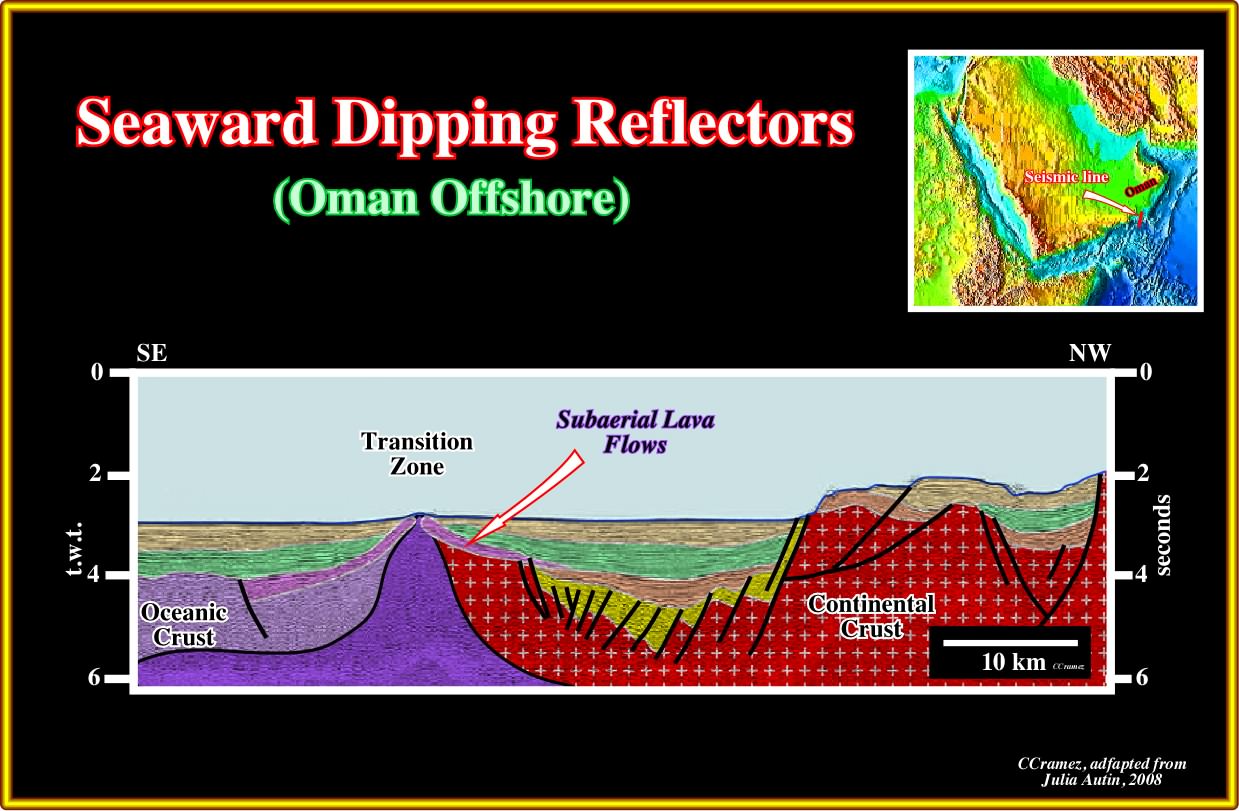
Plate 52.01- This tentative interpretation of a seismic line from Oman offshore strongly suggest that this Atlantic-type margin is volcanic. In fact, it is possible that after the lengthening of the lithosphere, during which rift-type basins were formed the breakup took place with emplacement of subaerial lava flows. However, since the subaerial spreading centres zincked under a relatively deep water depth, the volcanic material reaching the bottom of the sea formed the oceanic. On this area, an younger mantlic extrusion deformed (uplifted) the older subaerial lava flows pouring out new subaerial lava flows, which partially covered the distal part of the rift-type basin, as better illustrated on the next plate.
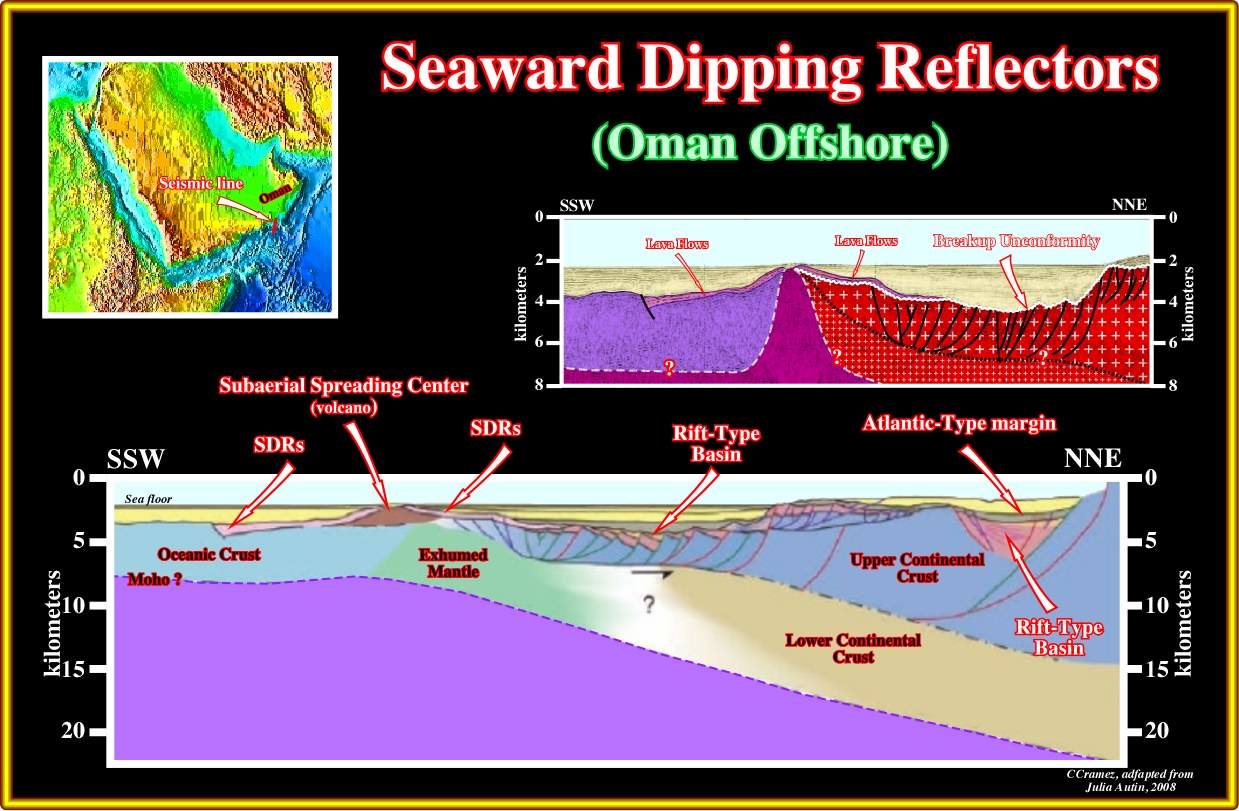
Plate 52.02- In a more regional line, in depth, of the same area of the previous seismic line,at the limit between continental and volcanic crust, a recent subaerial spreading centre (volcano) expelled volcanic material, which, clearly, form a cover the distal part of the continental crust and partially the rift-type basins developed during the lengthening of the upper continental crust. According to this tentative interpretation, the normal faults, developed during the lengthening of the lithosphere, die on the top of the lower continental crust, which disappear, laterally, into an exhumed mantle zone.
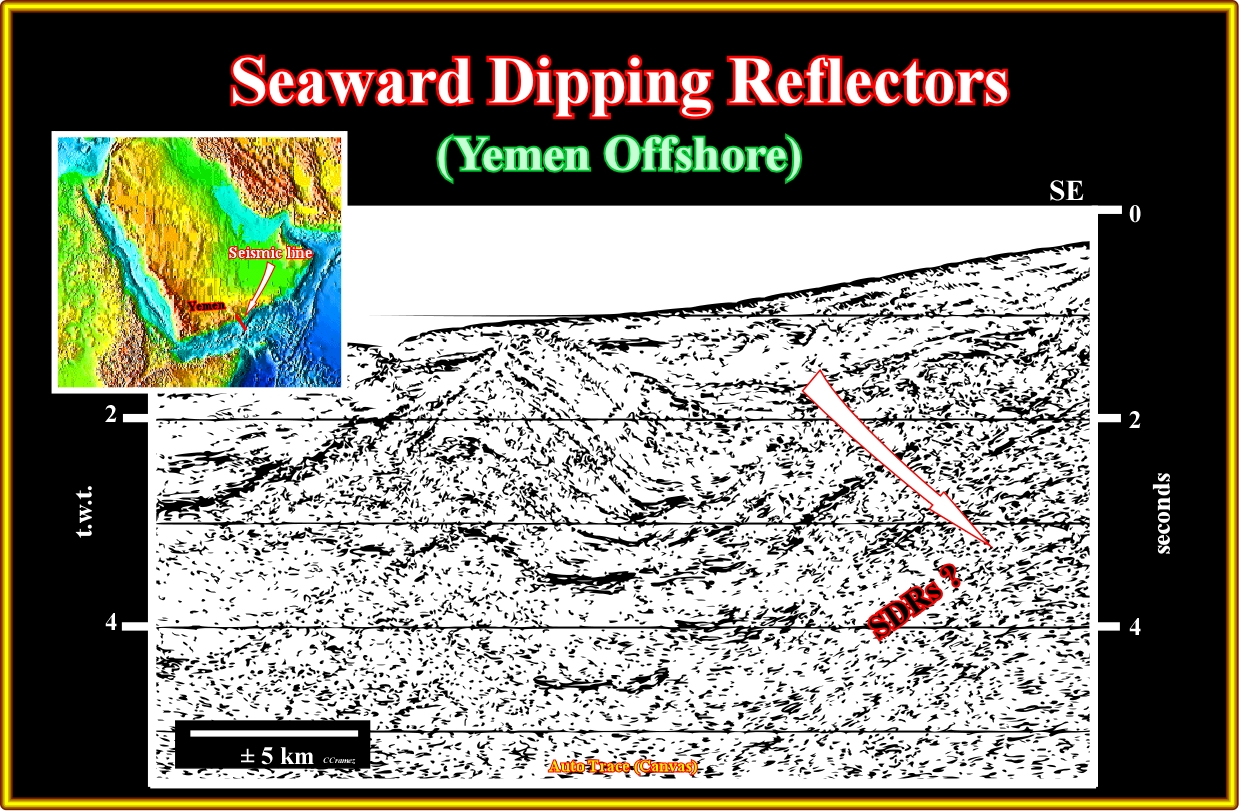
Plate A52.03- On this seismic line from Yemen offshore, not far from the seismic line illustrated on the previous plate, the dipping seaward seismic reflectors, in the lower eastern part of the line, can be subaerial lava flows, that is to say, subaerial lava flows emplacement after the breakup of the lithosphere. The antiform structure, recognized in the central part of this seismic line, was induced by lateral flowage of the evaporite interval deposited in the lower part of the margin. The salt composition, quite rich in potash, favour the hypothesis that the salt layer was deposited above basaltic material, eventually SDRs, which strongly enrich the brine in heavy mineral and potash (spilitization of basaltic material, probably SDRs, by oceanic water).

Plate A53.01- As illustrated, after the breakup of the Pangea, a large amount of subaerial volcanic material deposited the Pakistan offshore before the deposition of the margin sediments. Consequently, this offshore corresponds to a volcanic Atlantic-type margin. In fact, not only the recognized seismic patterns (seamounts, lava deltas, seaward dipping reflectors, craters, etc.) are characteristics, but exploration wells's results as well. The subaerial deposition of the lava flows is not refuted by the deposition of shallow water reefal carbonates, which were later fossilized by deep water sediments, particularly slope fans.
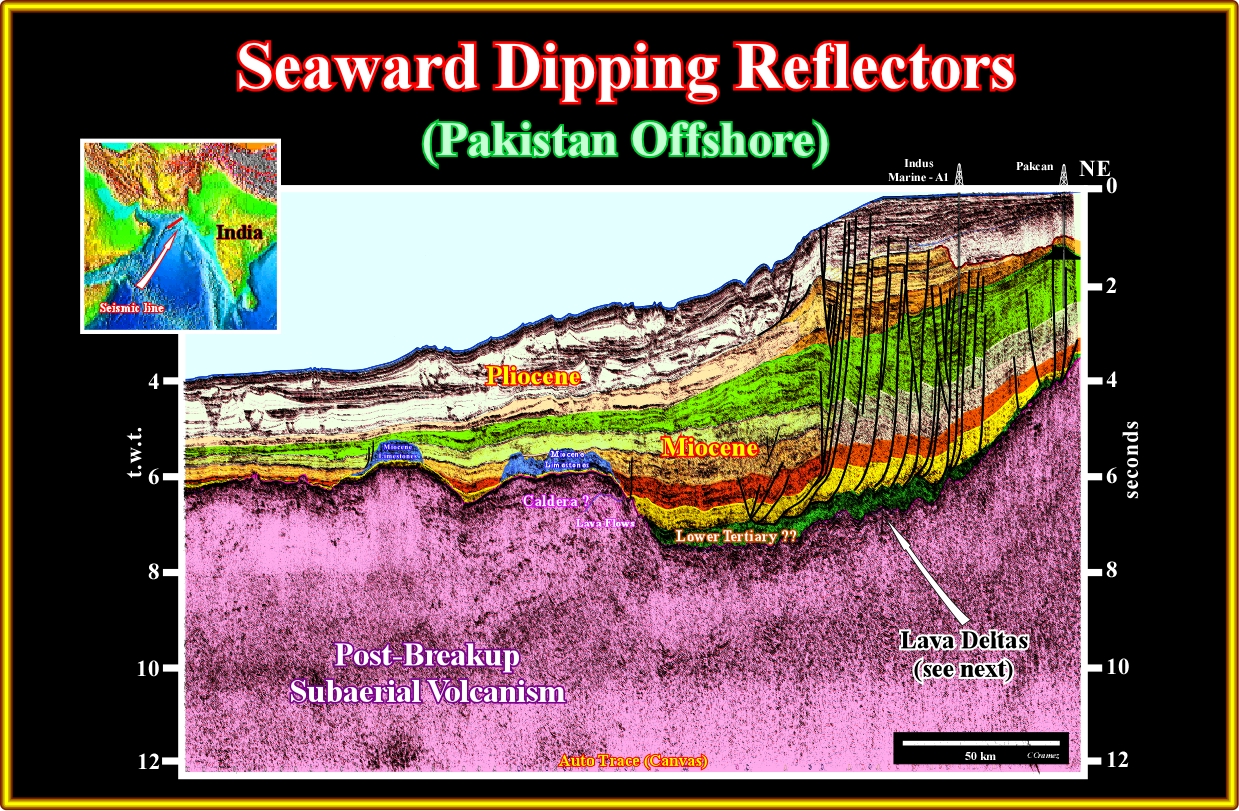
Plate A53.02- On this tentative interpretation, the carbonate buildups are quite obvious above volcanic high, which can be interpreted as major volcanos since the calderas and the associated subaerial lava flows are easily recognized. On the lower left part of this tentative interpretation, the presence of lava deltas is obvious (white arrow). Take into account the changing in water depth to get a more realistic picture of the geometry of the margin.
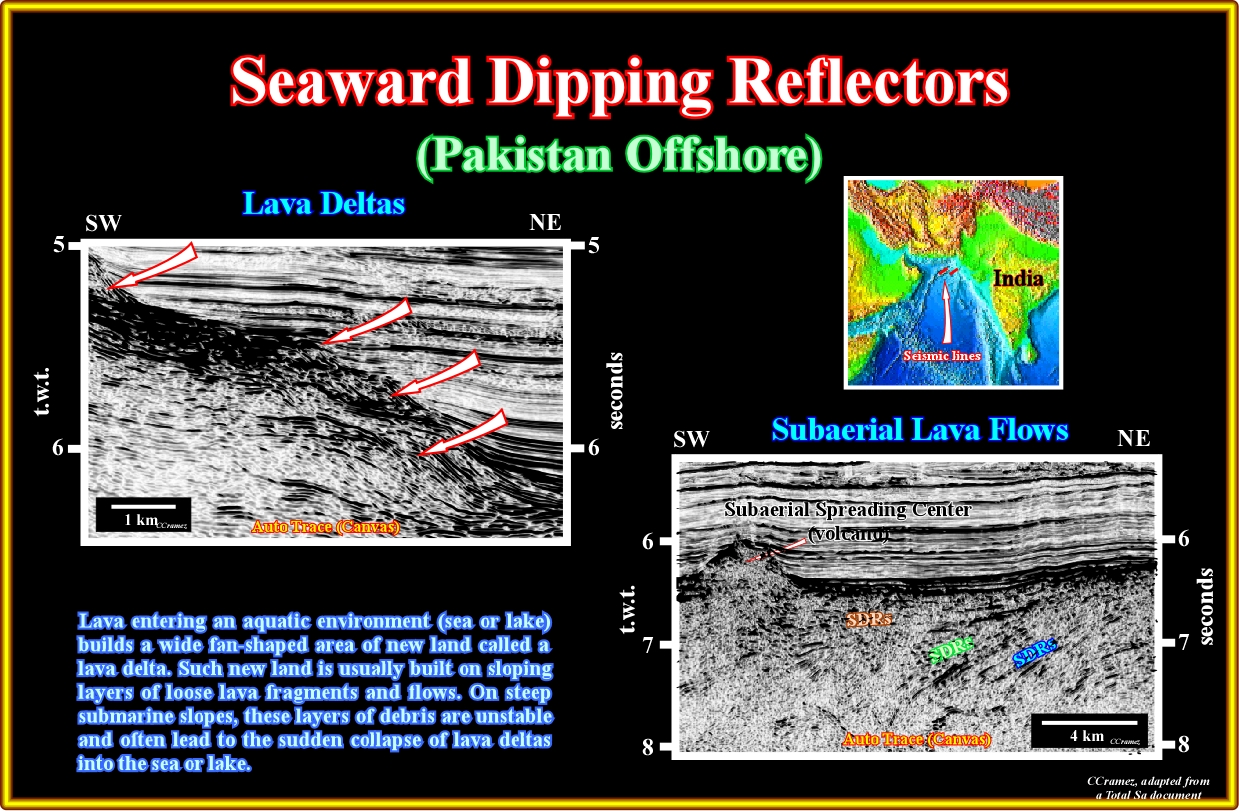
Plate A53.03- On this close-ups the presence of SDRs, that is to say, seaward dipping reflectors interpreted as subaerial lava flows, and lava deltas are evident. Several geoscientists tentatively perform sequential stratigraphy on the lava-deltas. However, the mechanism of deposition seems quite different particularly the role of the relative sea level change in creation of space available (accommodation) for deposition. On the close-up in the lower left corner, several SDRs' wedges are visible as well as an younger volcanic plug, which can be considered as a secondary subaerial spreading centre.

Plate A54.01-- Before all, on this regional seismic line, take into account the lateral change in water depth. Then, on the lower left part of the line, recognized the seaward dipping reflectors (thinning continentward) that, partially, cover the distal rift-type basins, developed during the lengthening of the Pangea lithosphere, as suggested in the tentative interpretation illustrated in next plate.

Plate A54.02- On this tentative interpretation, below the Atlantic- type margin sediments, that is to say, below the breakup unconformity (breakup of the Pangea, from West to East, it is easy to recognize : (i) SDRs, that is to say, reflectors dipping and thickening seaward, which, likely correspond to subaerial lava flows; (ii) A rift-type basin, developed during the lengthening of the Pangea lithosphere and partially fossilized (covered) by the landward termination of the lava flows ; (iii) Gondwana continental crust and (iv) Another rift-type basin, which parallel internal configuration suggest the presence of organic rich lacustrine sediments (potential source-rocks).

Plate A54.03- On this regional seismic line, seaward dipping reflectors are likely westward of the Gondwana continental crust. These SDRs were deformed by a recent volcanic plug, which locally change the dip of the SDRs continentward Again, take into account the lateral variation of the water-depth to get a better picture of the margin's geometry. Note the presence of volcanic sill eastward of the volcanic plug.
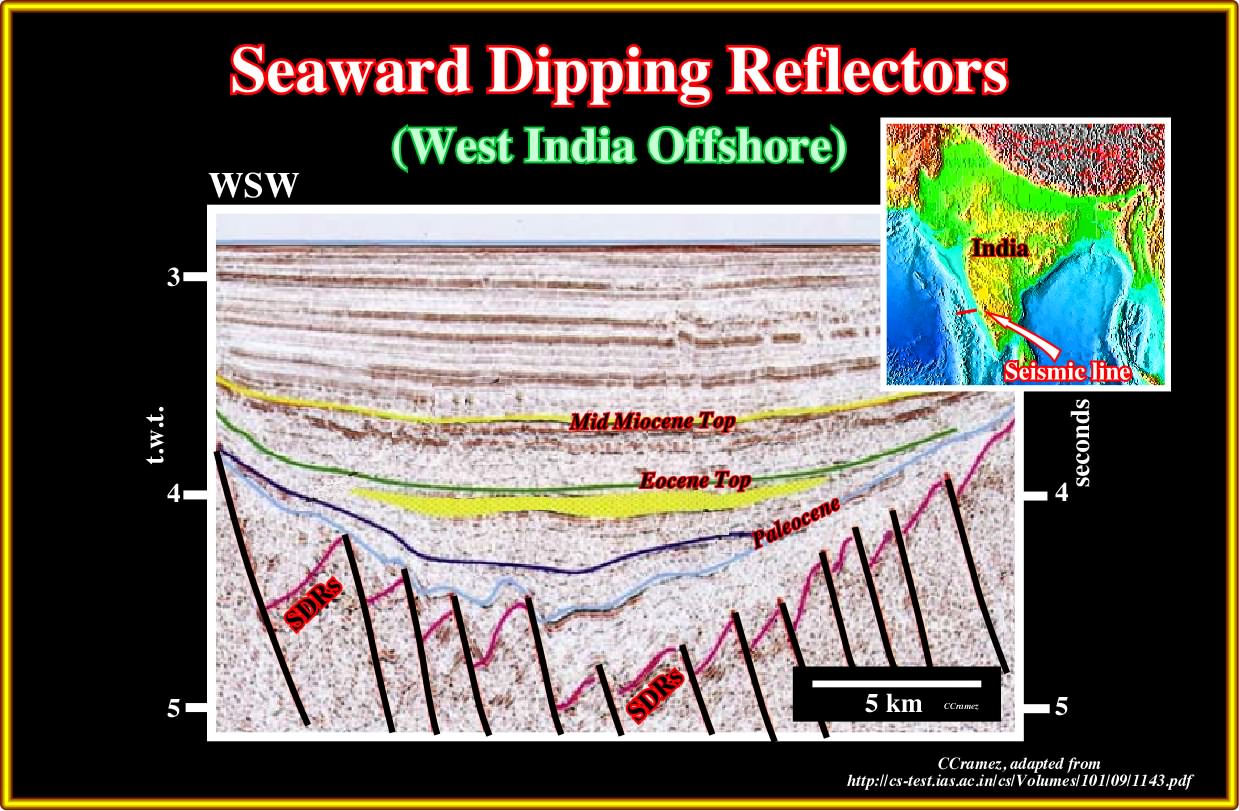
Plate A54.04- In this tentative interpretation of the seismic line of the southwest India offshore, the interpreter considers the faulted lower most reflectors as seaward dipping reflectors. If that is so, the SDRs were lengthened by a regional extensional tectonic regime, what is difficult to realize, since they postdate the breakup unconformity, that is to say, the lengthening of the Gondwana continental crust. An alternative to this interpretation, is to consider the lengthened dipping reflectors as belonging to the continental crust and overlying sediments (Paleocene sediments) as infilling a rift-type basin, since the normal faults can be easily prolonged upward until the top of Paleocene sediments.
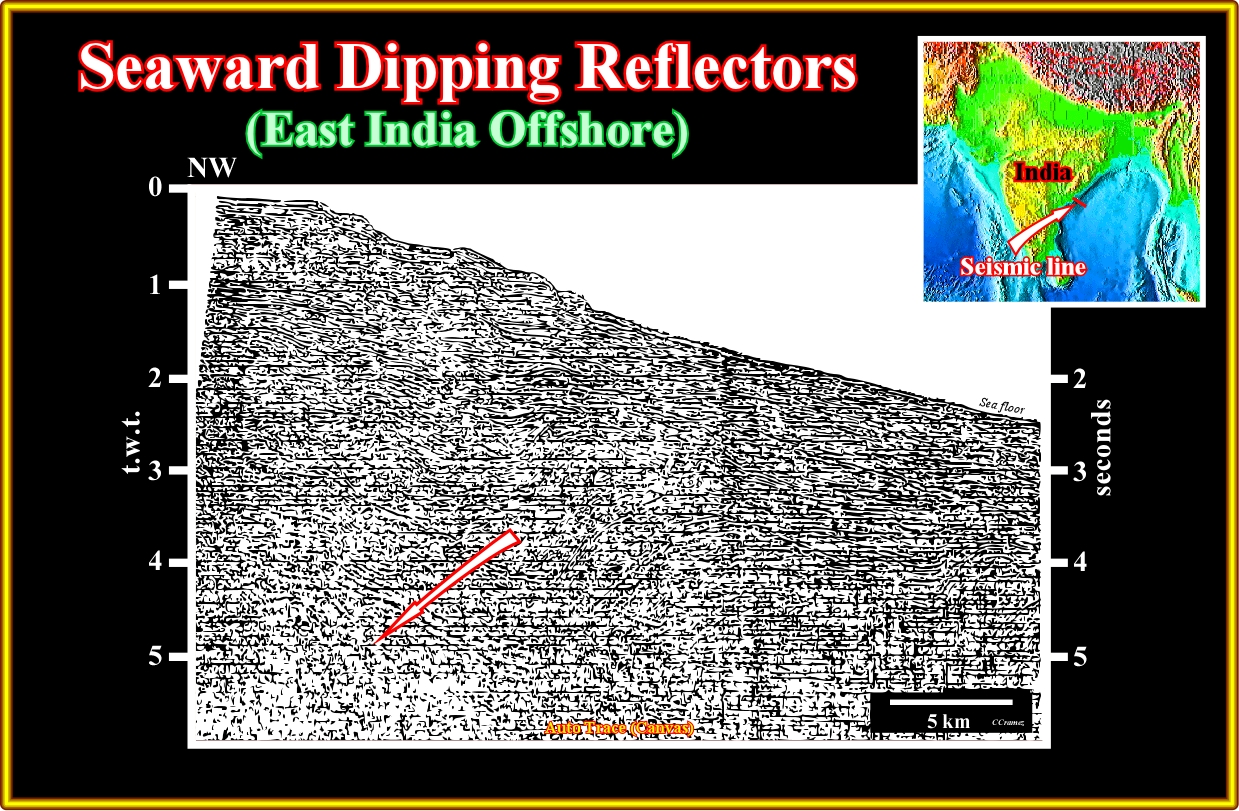
Plate A55.01- On this unmigrated seismic line of the East India offshore, seaward dipping reflectors, that is to sa, subaerial lava flows, and two volcanic plugs are, easily, recognized, as suggested in the tentative interpretation illustrated in the next plate.

Plate A55.02- In this tentative interpretation, above the breakup unconformity (BUU), a thinning continentward interval with a divergent seaward internal configuration is easily recognized. This interval is composed by seaward dipping reflectors (SDRs) and bounded by two unconformities (BUU and SU. The SU unconformity, which corresponds to the top of the subaerial lava flows (underlines roughly the passage of the SDRs to the oceanic crust or pillow lava), is considered by several geoscientists as the marine (or oceanic) breakup unconformity in contrast to the BUU unconformity, that they consider as the subaerial or continental breakup unconformity. Two volcanic plugs postdating the SDRs' emplacement are easily perceived.
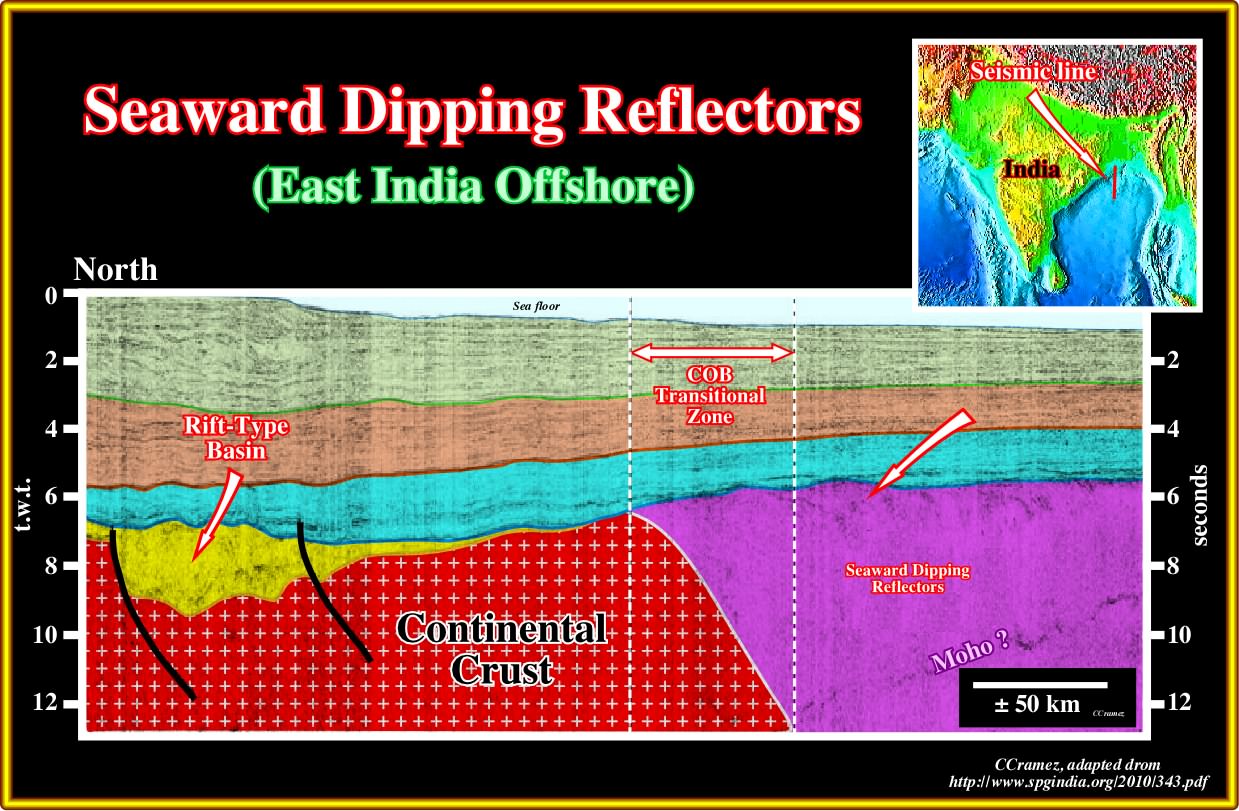
Plate A55.03- On this tentative interpretation of a mega regional line of the East India offshore, the COB (continental oceanic boundary) is here defined by the interface between the Gondwana continental crust, in which rift-type basin developed during the lengthening of the lithosphere, and the SDRS, which laterally pass to the oceanic crust). In the lower left part of the seismic line the reflectors dipping continentward, likely, underline the Moho disconformity.
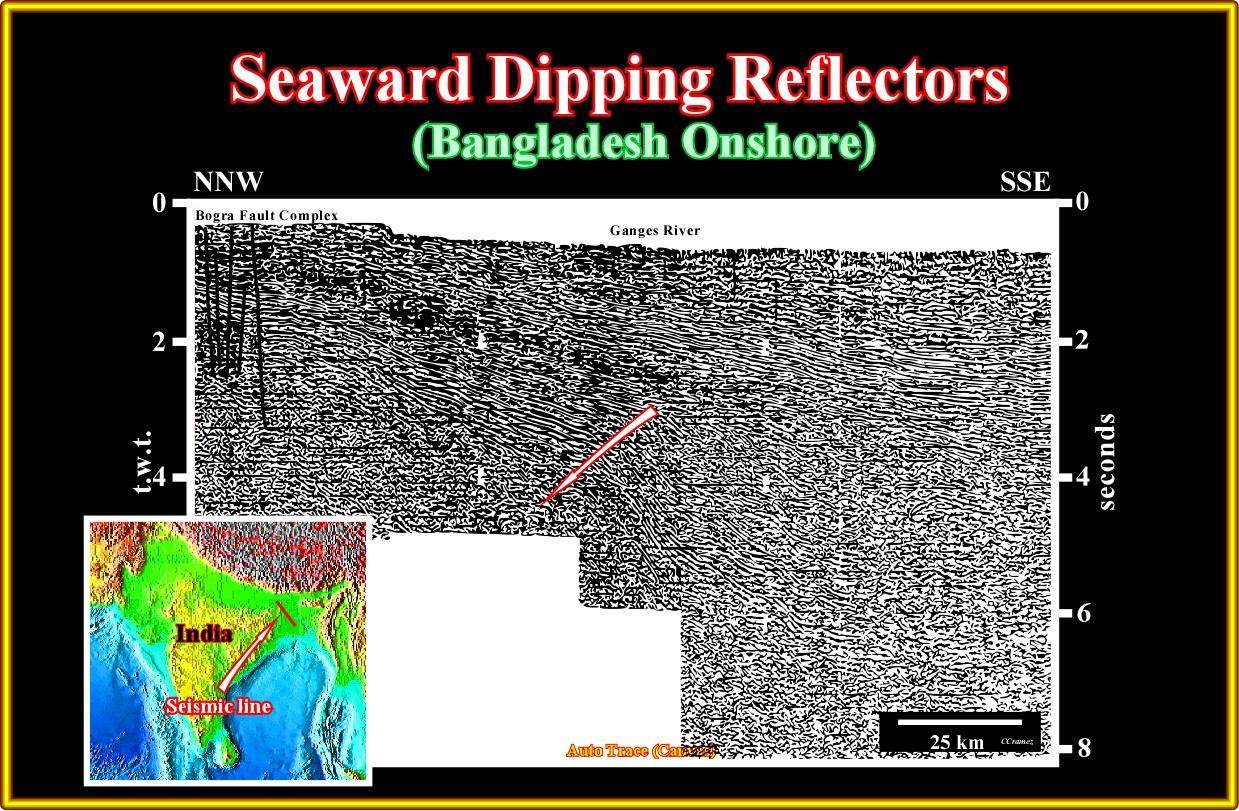
Plate A56.01- On this regional line of the Bangladesh onshore, geoscientists knowing the regional tectonic context of the area and the breakup mechanism of the Gondwana (southern continent of the Pangea supercontinent) recognize, readily, SDRs accreting the continent crust, before the oceanization (formation of the oceanic crust) of the margin, as illustrated in the next plate-
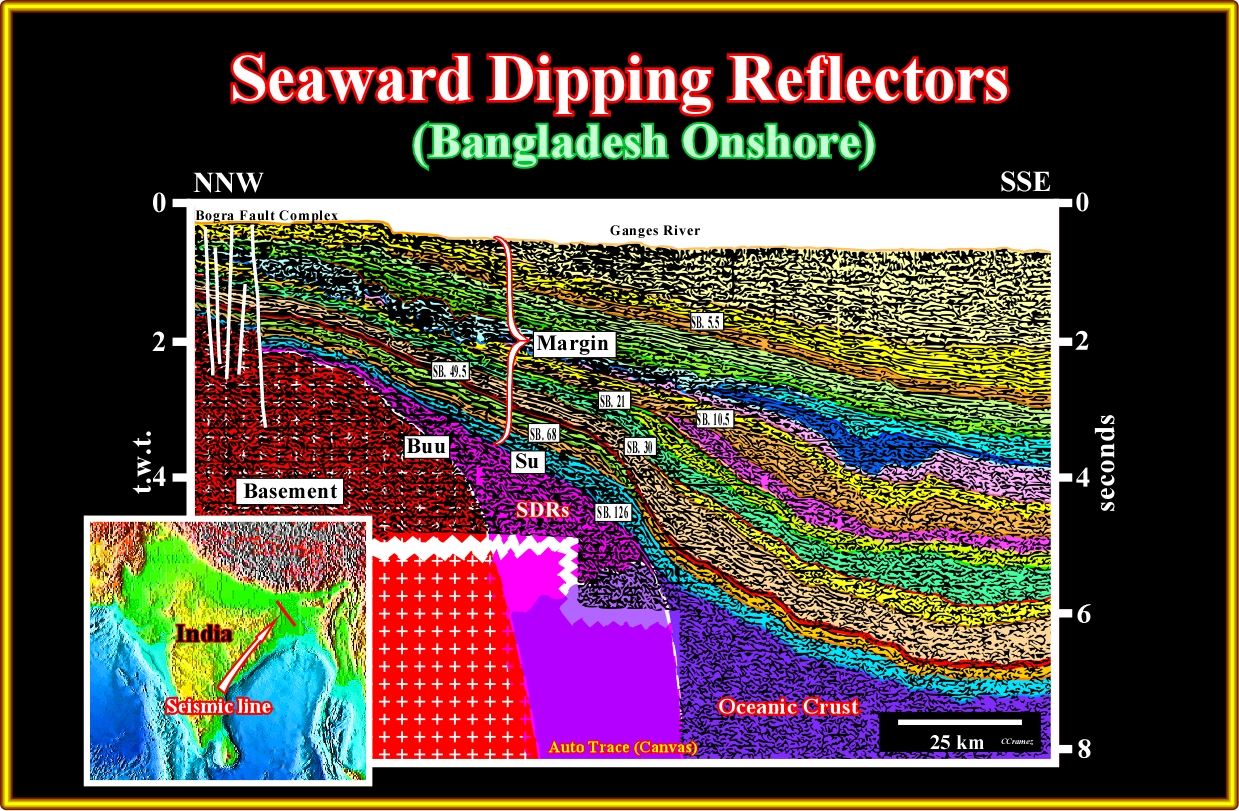
Plate A56.02- The presence of SDRs (seaward dipping reflectors interpreted as subaerial lava flows) is corroborated by the exploration wells drilled southward of the Bogra fault complex. In spite of the fact that the limit between the SDRs and the oceanic crust is speculative, the morphology of the bottom of the margin sediments (top of volcanic crust) strongly suggest an oceanic volcanic substratum (oceanic crust).
A57- North & Northwest Australia Offshore (Kaitanimbar):
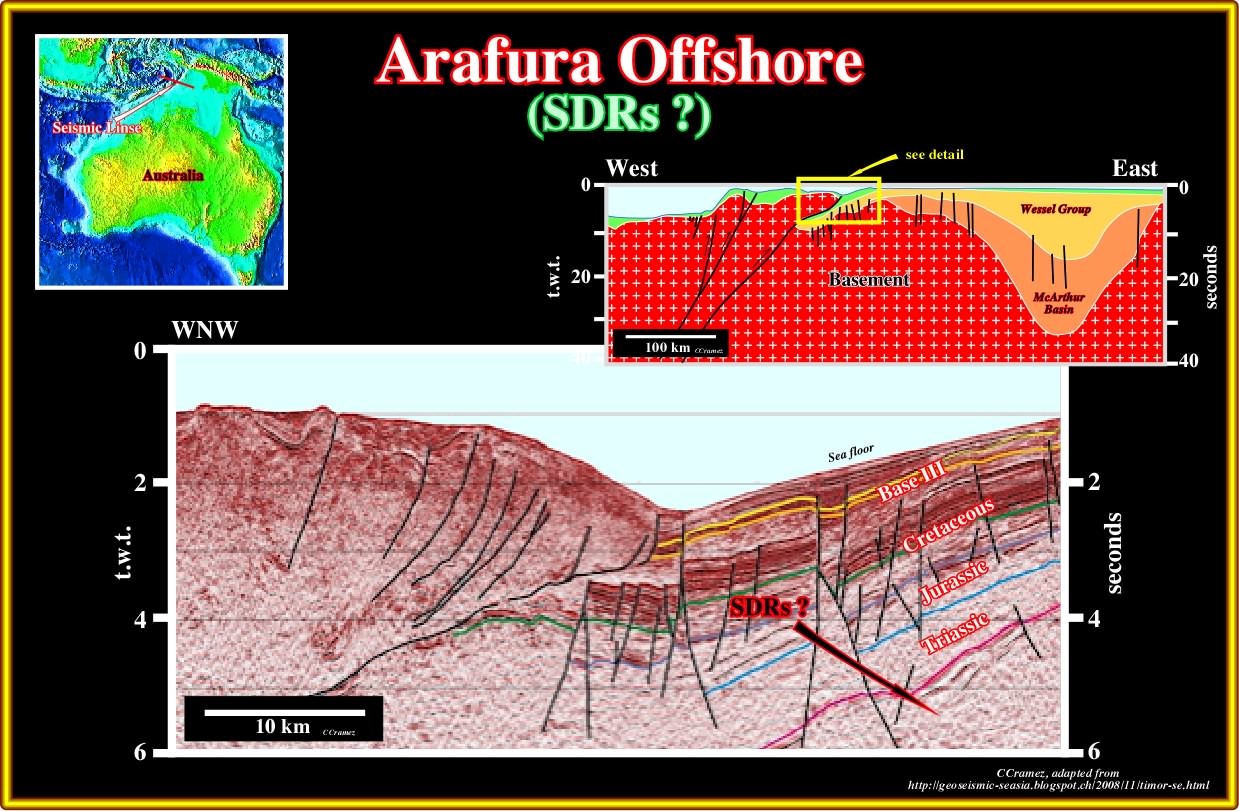
Plate A57.01- On this tentative interpretation, the reflectors below the Triassic interval, can provisionally be considered as SDRs, since their stratigraphic position, dipping and thickening are those of the subaerial lava flows postdating the breakup of the Gondwana continent. In the upper right part of this plate, the seismic line is placed in its global context, which seems to correspond to a collision between two margins or between a margin and an oceanic plate, in which the sinking plate is continental.
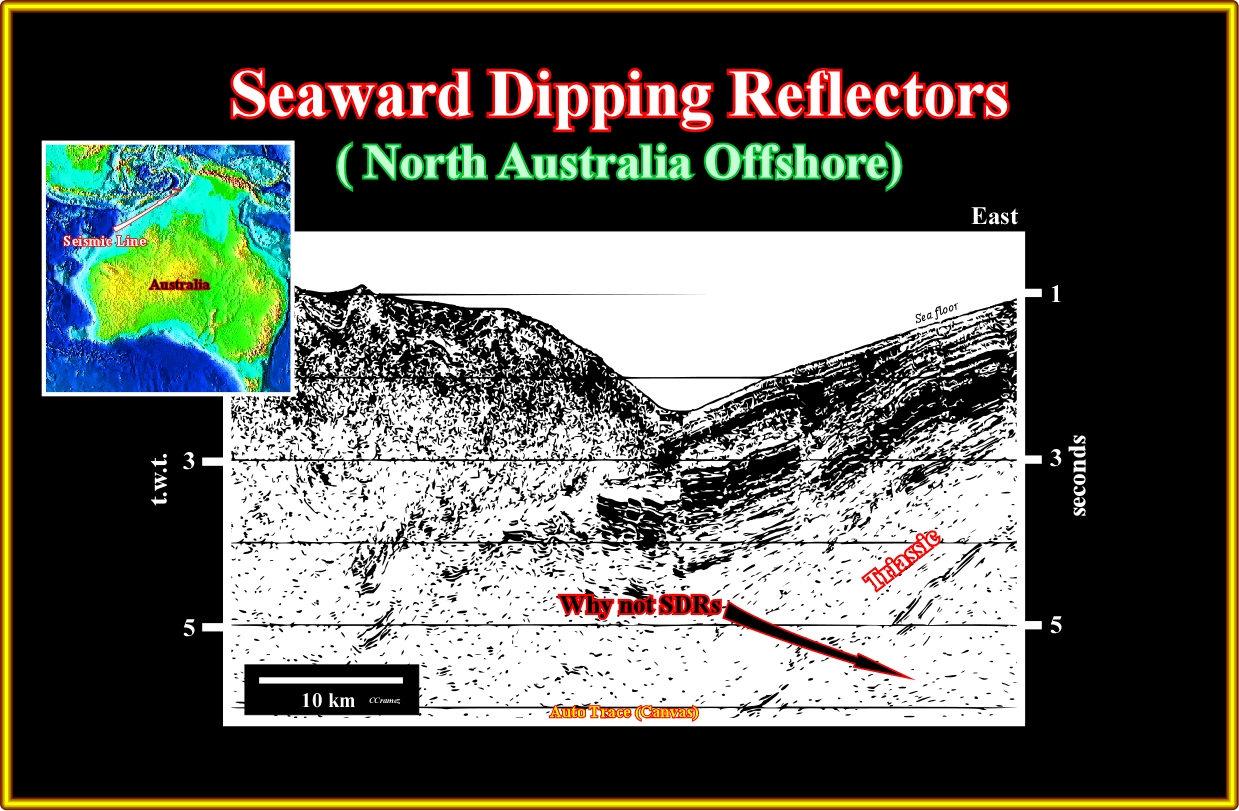
Plate A57.02- On the uninterpreted seismic line (the tentative interpretation is illustrated in the previous plate), the internal configuration of the interval interpreted as subaerial lava flows is more evident. In fact, the reflectors dip seaward and the interval configuration is divergent, that is to say, the interval between two consecutive successive reflectors thins landward away of the spreading centres.
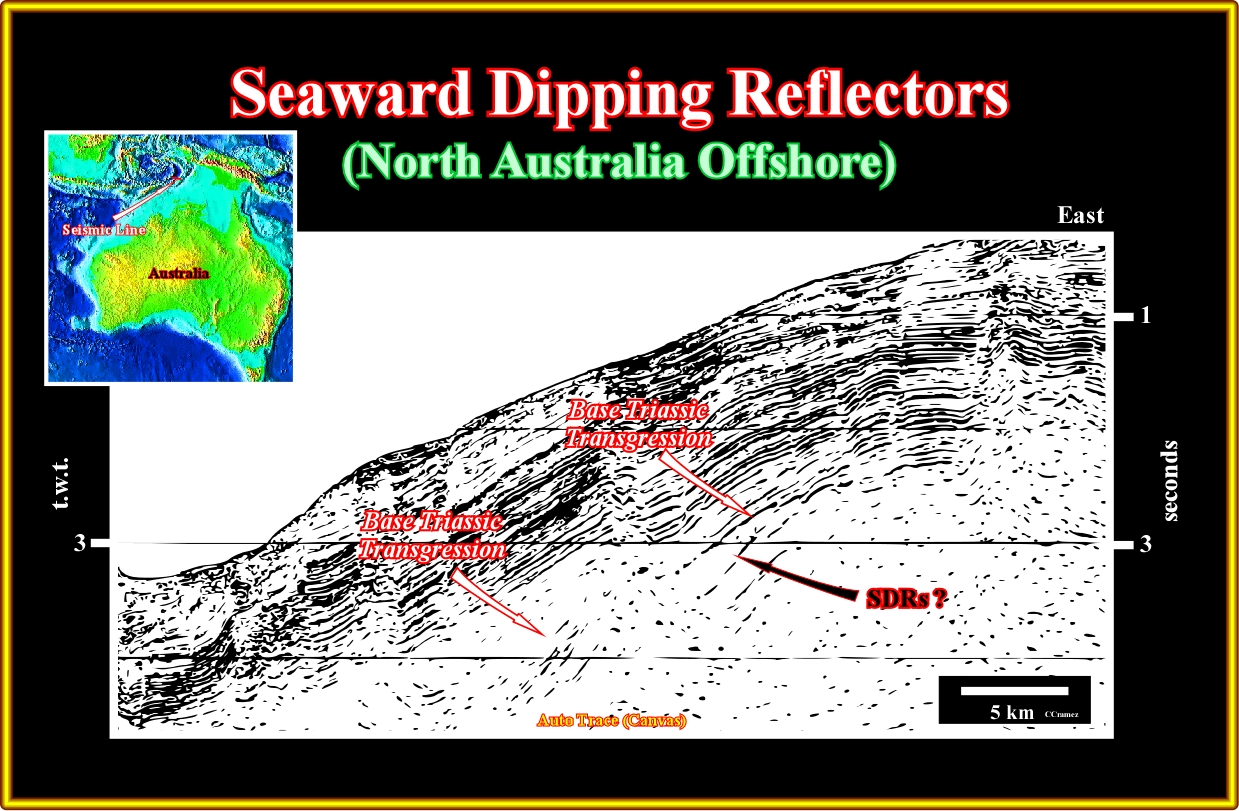
Plate A57.03- On this seismic line, more or less parallel to the line illustrated on previous plates, below the transgressive Triassic sediments, the dipping seaward reflectors can be tentatively interpreted subaerial lava flows. In other words, the north Australian Alantic-type margin can be considered as a volcanic.
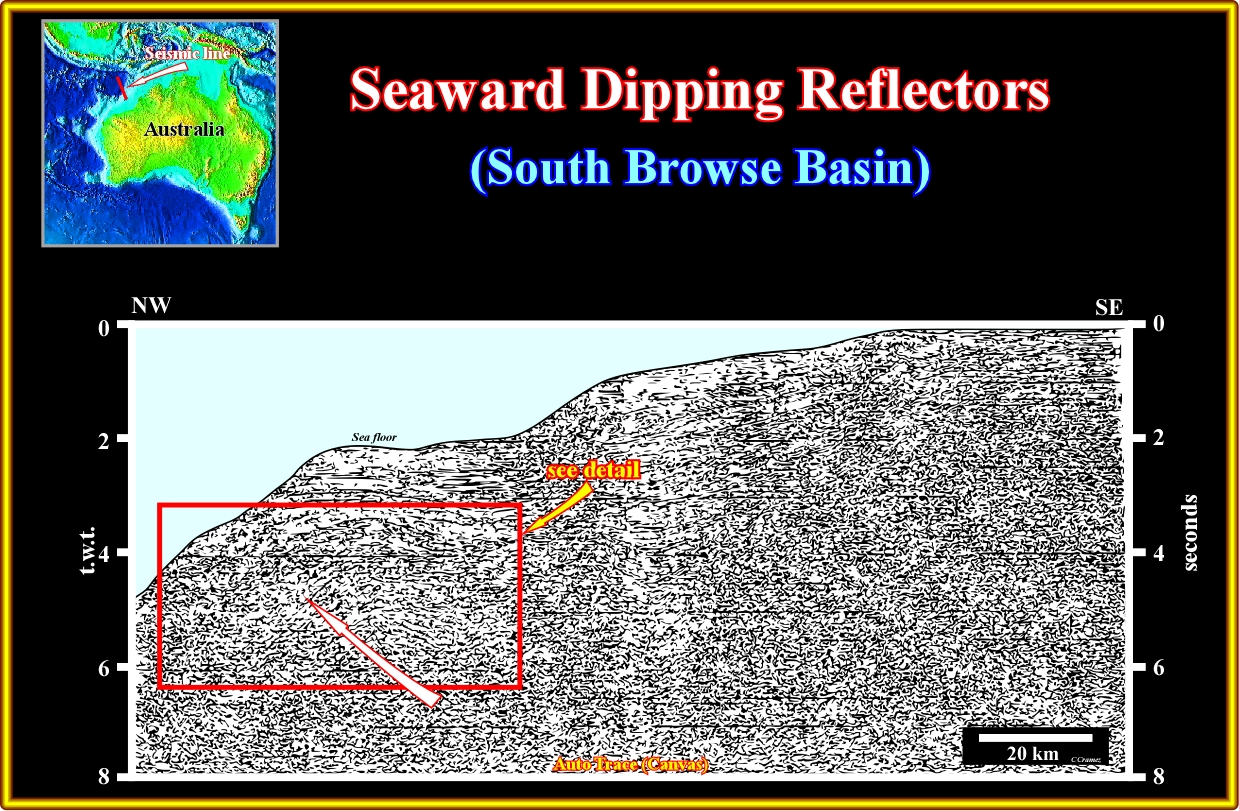
Plate A57.04- The seaward dipping reflectors are obvious on the Browse basin offshore, as one can check on the close-up illustrated on the next plate.
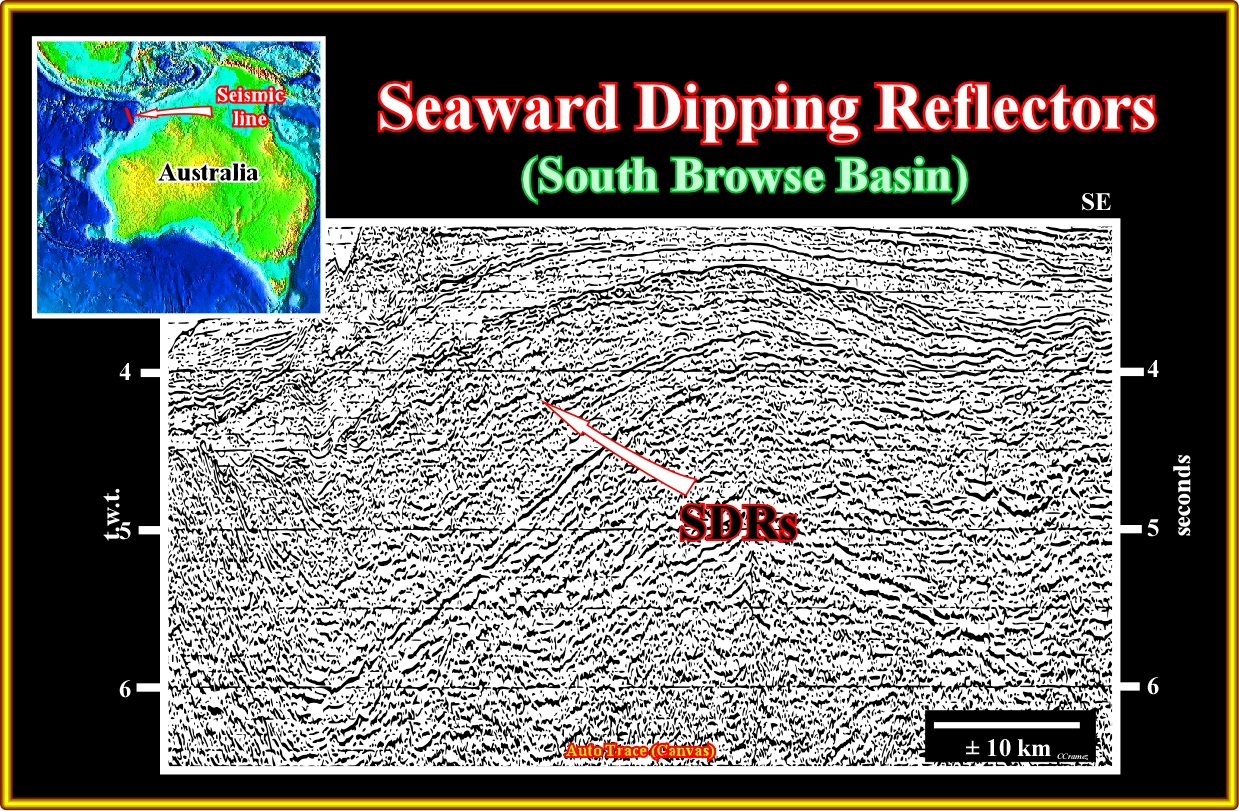
Plate A57.05- On this close-up, the seaward dipping reflectors, that is to say, the subaerial lava flows, which postdate the breakup unconformity of the Gondwana supercontinent, are obvious. Indeed, the reflectors not only dip seaward, but the interval between successive reflectors thin continentward away from the subaerial spreading centres.
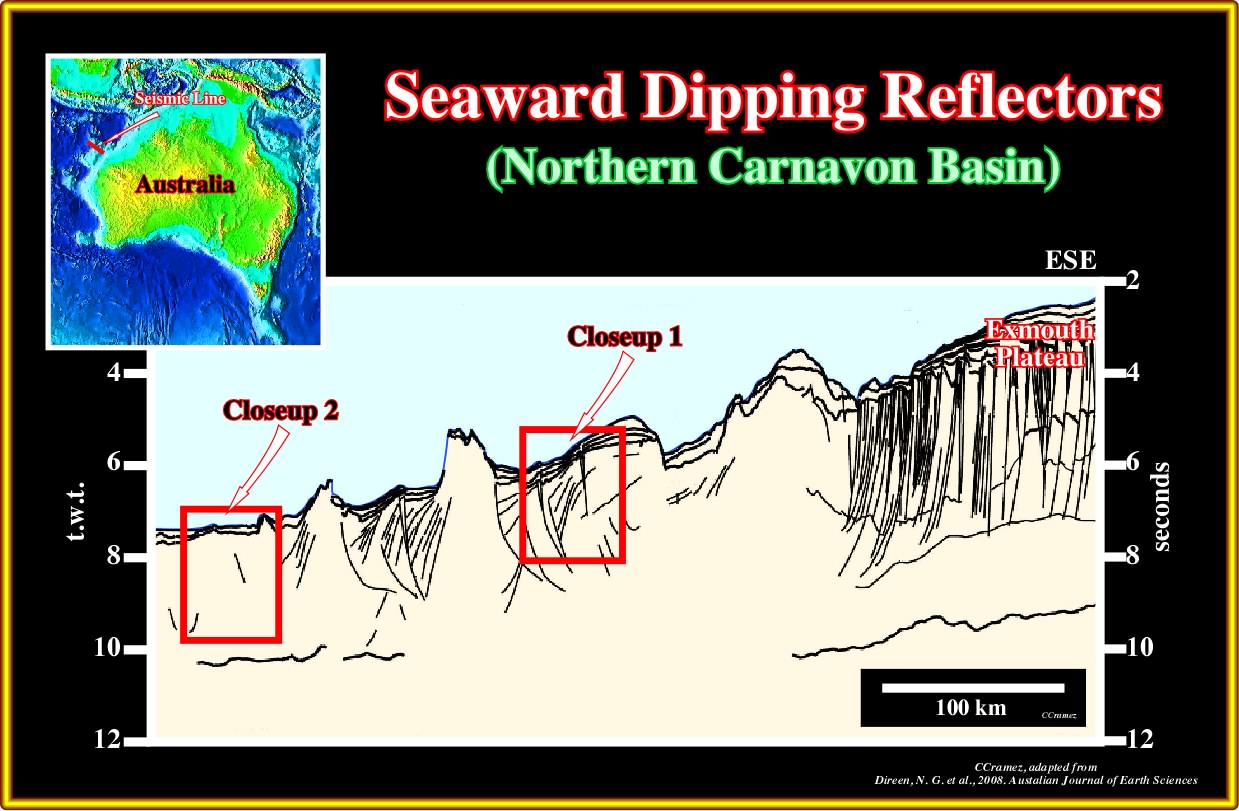
Plate A58.01- On this tentative interpretation of a mega regional seismic line of the Carnavon basin (West offshore Australia) several geoscientists recognized SDRs (subaerial lava flows) and oceanic crust. The close-ups illustrated on the next plates corroborate their conjectures.
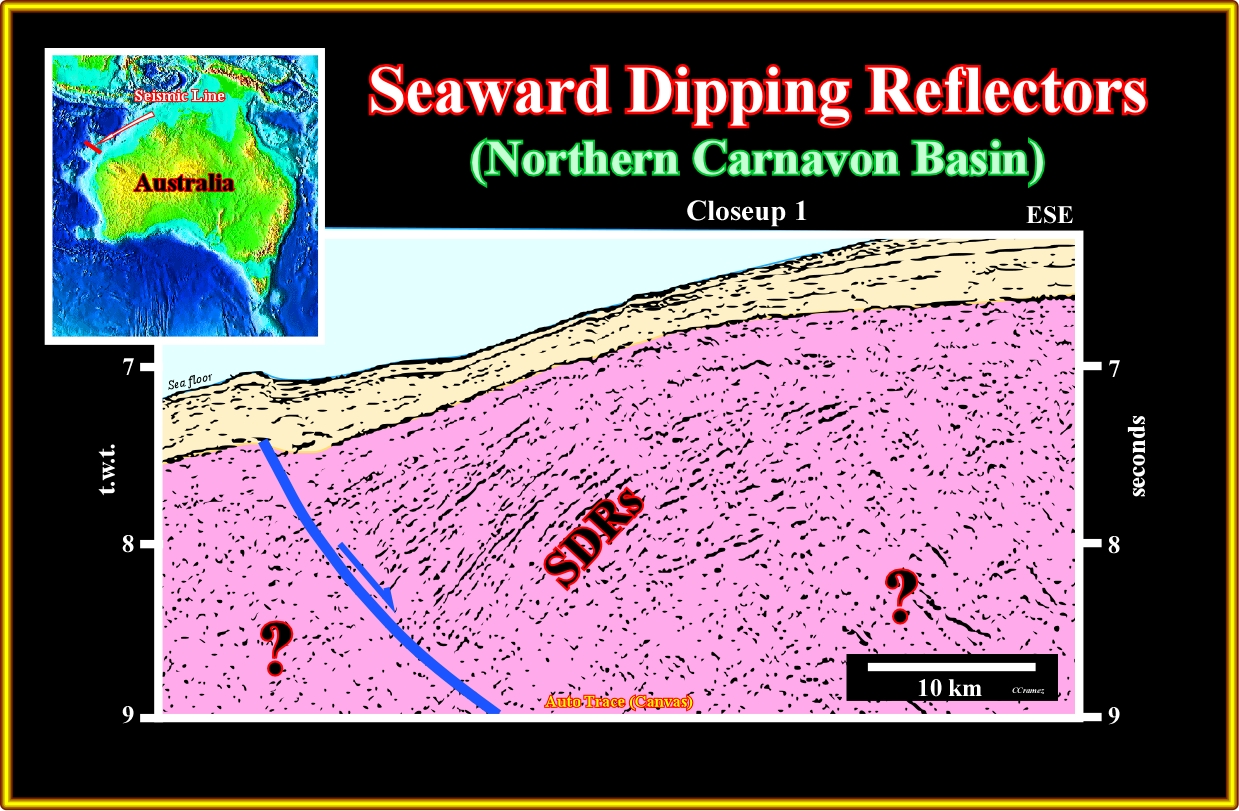
Plate A58.02- Here, that is to say in close-up 1, the untested subaerial lava flows look evident. The reflectors deep seaward and the interval between successive reflectors thins away from the spreading centres in the direction o the continent.
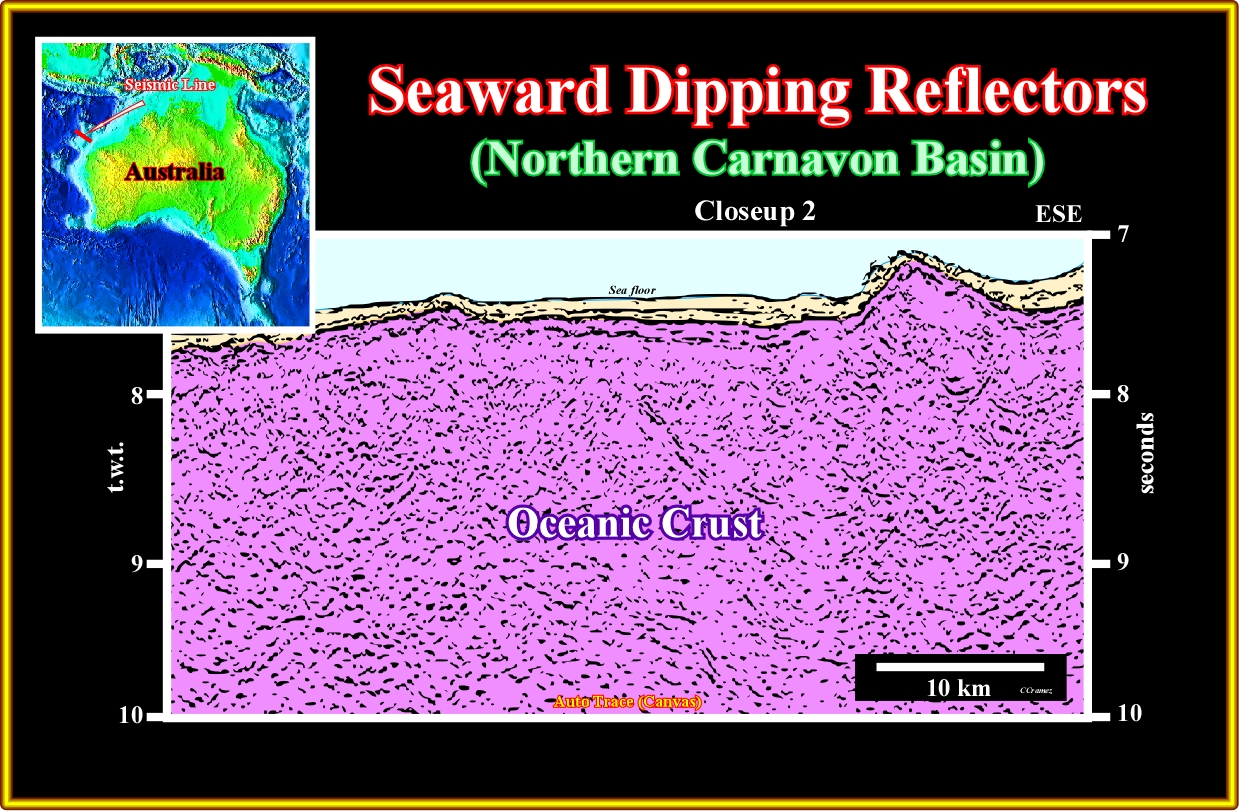
Plate A58.03- On the distal close-up 2, the absence of reflectors dipping seaward and the morphology of the volcanic material suggest more oceanic crust, that is to say, pillow lava than subaerial lava flows.
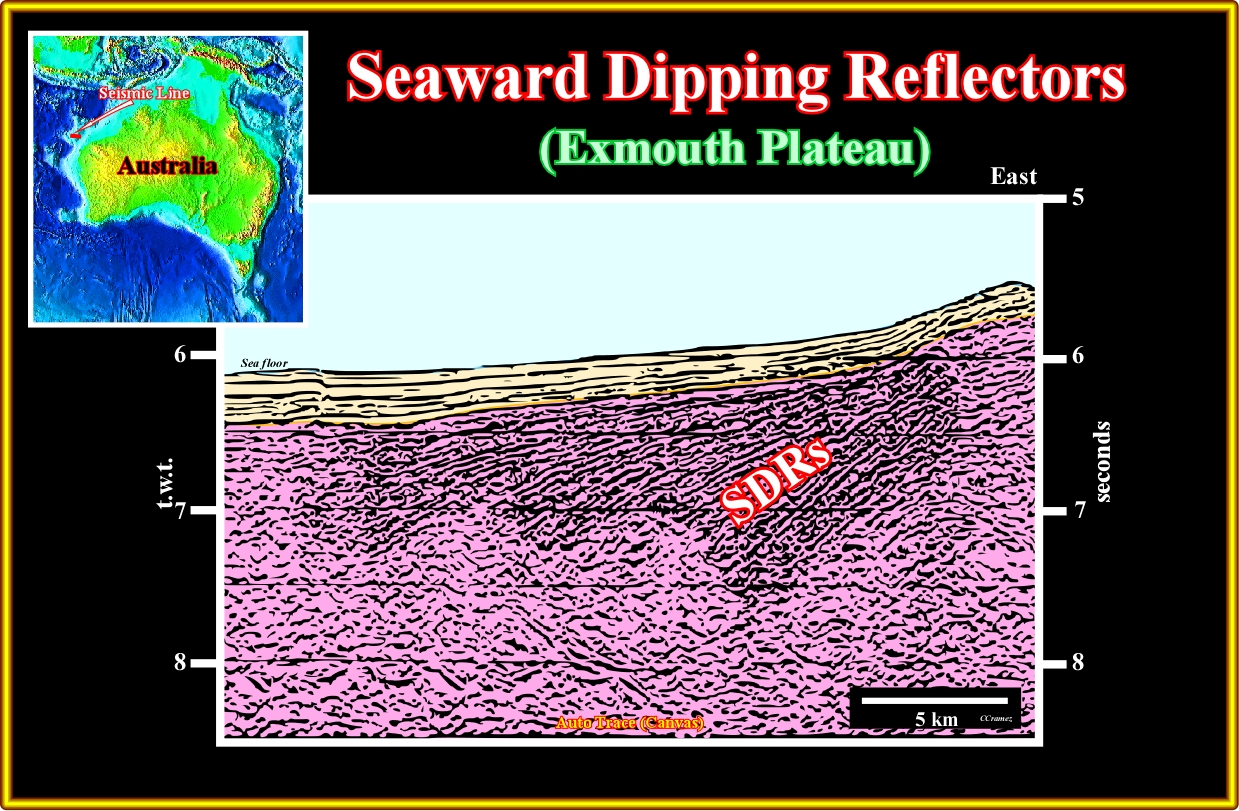
Plate A58.04- This seismic line of the Exmouth Plateau is good enough to considered the margin as an Atlantic-type volcanic margin. Several wedges of SDRs are obvious.
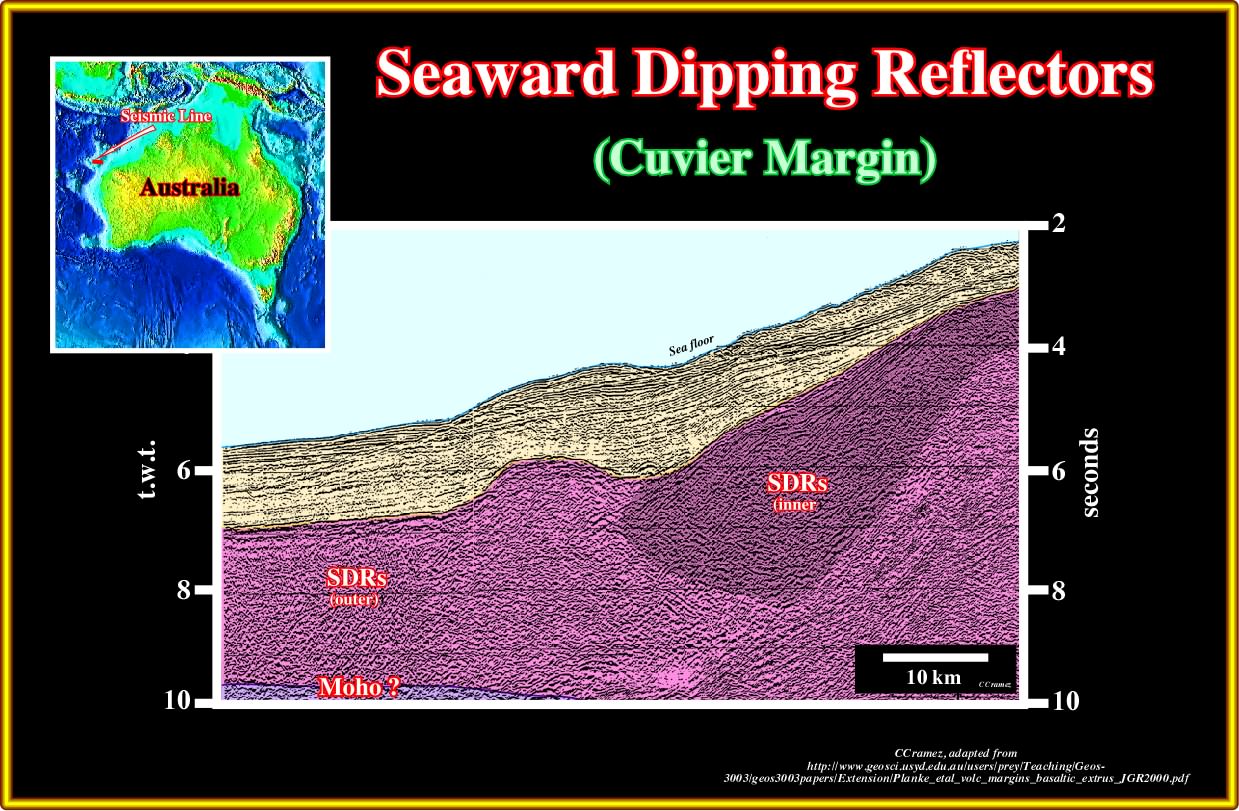
Plate A58.05- Here, in the Cuvier margin, not far from the area where the previous lines was shot, SDRs more or less deformed by posterior volcanic plugs are quite evident.

Plate A58.06- In this tentative interpretation of a mega regional line of West Australia offshore, SDRs are recognized between the Wallaby Saddle and Carnavon Terrace. Likely these seaward dipping reflectors correspond subaerial lava flows postdating the breakup of the Gondwana.
A59- South Australia Offshore:
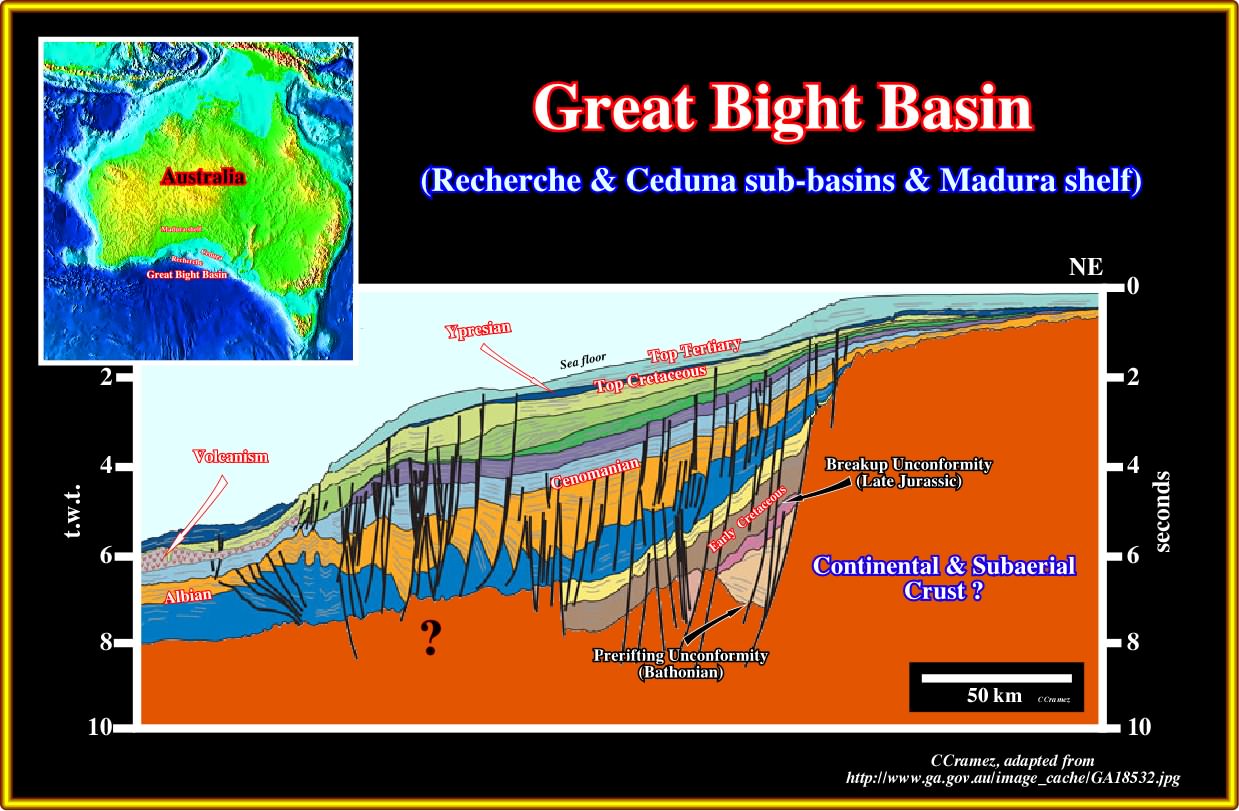
Plate A59.01- In this tentative interpretation of a regional line of the South Australia offshore, SDRs are not evident, in spite of the fact that a lot of volcanics has been recognized on the seismic lines as illustrated next.
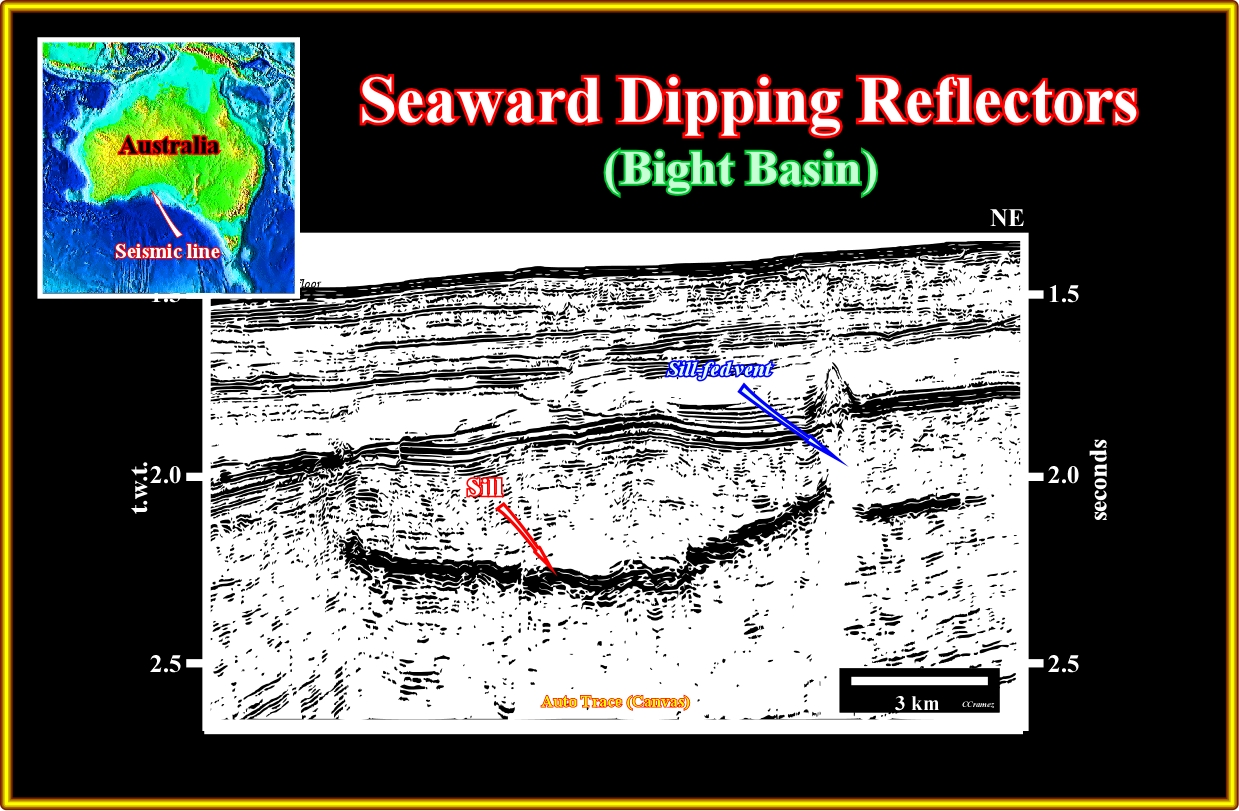
Plate A59.02- Here in the Bight basin, volcanic sills and silled vents are obvious, while, in other lines, volcanos and associated lava flow are recognized as illustrated next.
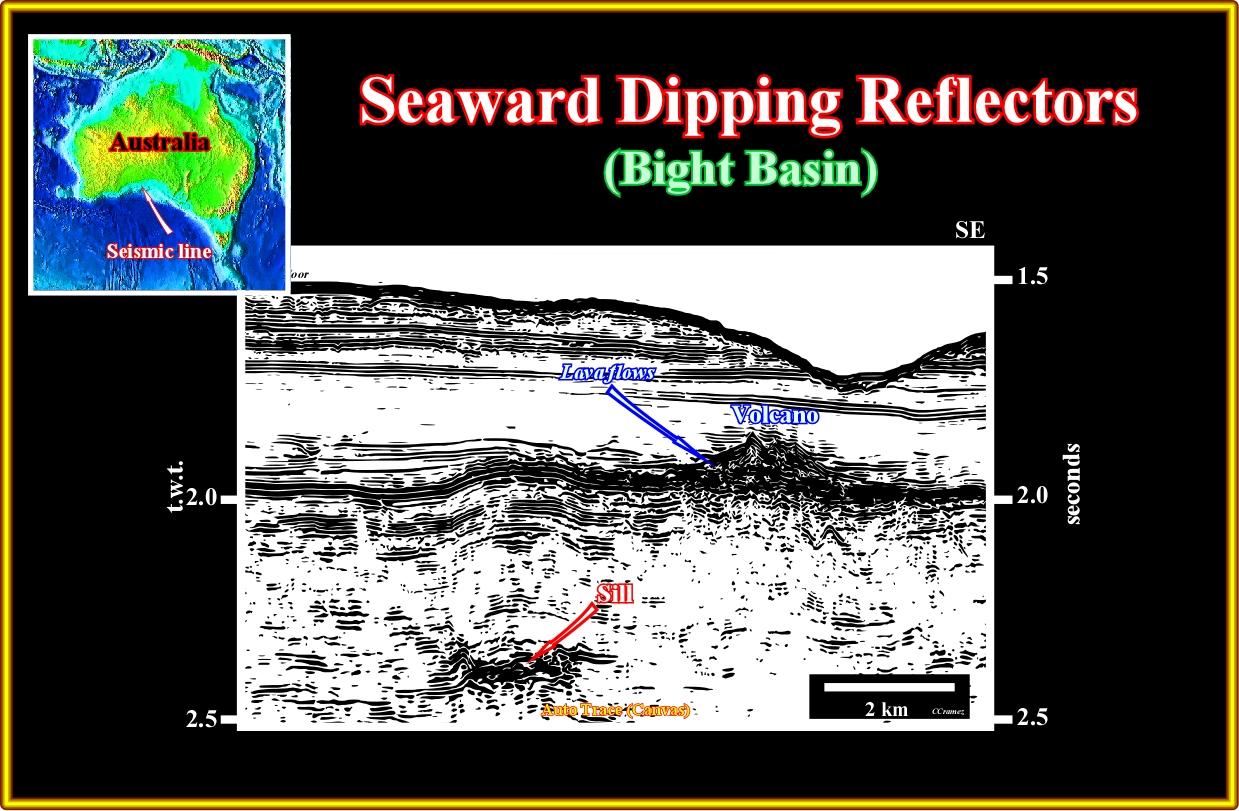
Plate A59.03- A volcanic sill, in the bottom of this close-up, and a volcano with the associated lava flows are evident around 2 seconds (t.w.t.) depth.
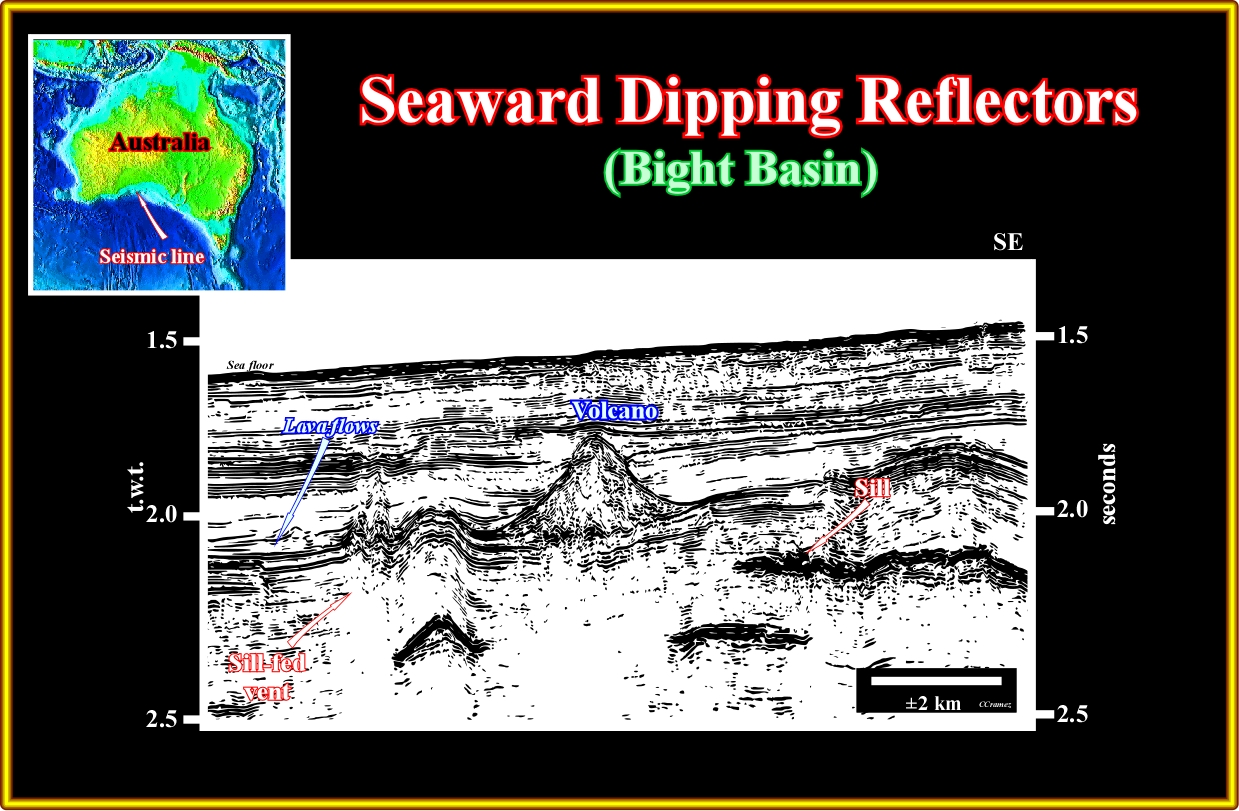
Plate A59.04- Here, again, in Bight Basin, the volcanic activity during the Atlantic-type margin is paramount. In other words, in spite of the fact that we don't have a seismic evidence of SDRs (seaward dipping reflectors), the volcanic activity during the deposition of the margin sediments may suggest that the margin is volcanic, that is to say, developed over a volcanic substratum.

Plate A60.01- This palinspatic reconstruction of the eastern part of the Gondwana (more or less at 130 Ma) strongly suggests the possibility of SDRs in West and East Australia, as well as in north and south Antarctic in association with oceanic plateau basalts, continental flood volcanics and continental mafic magmatism.
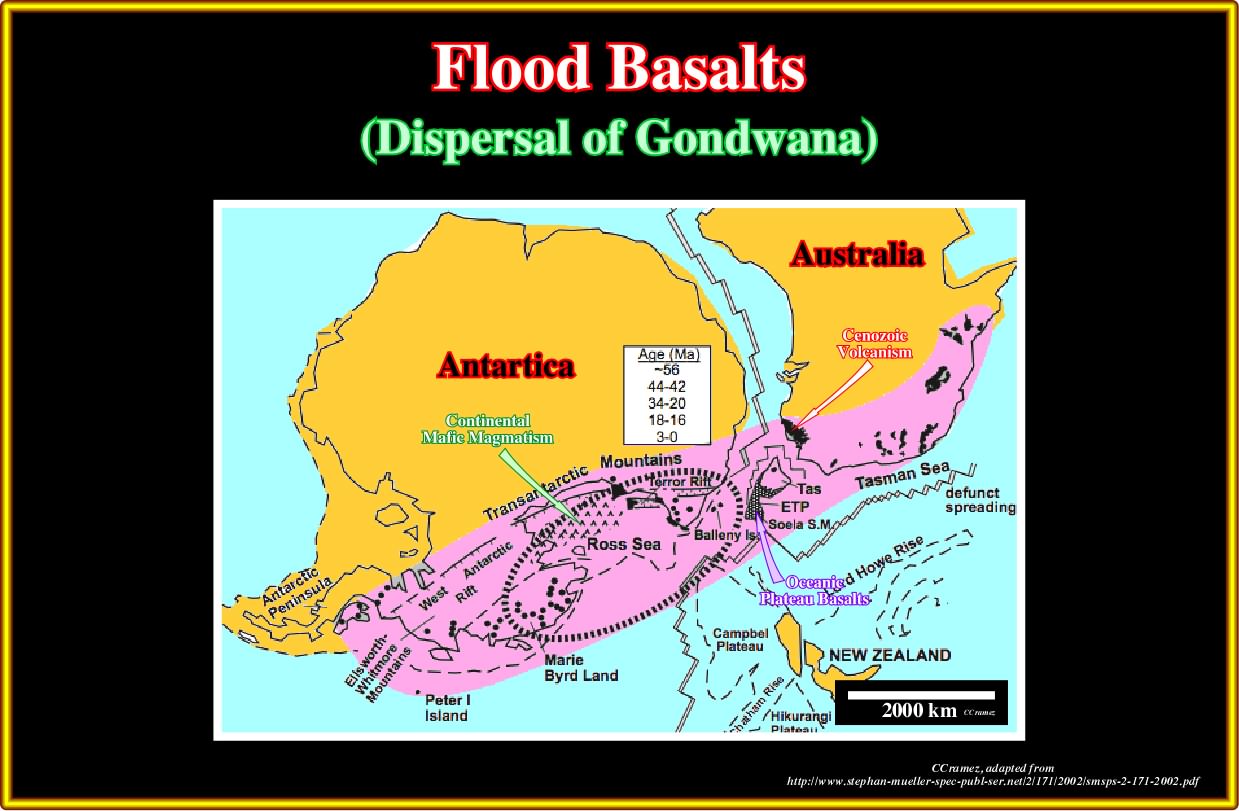
Plate A60.02- Around 40-45 Ma, after the West Antarctic and Terror rifting, subaerial lava flows probably were emplaced in association with the accretion of the South Antarctica (Ross Sea) and Eastern Australia (Tasman Sea). Notice in this reconstruction the Cenozoic vulcanism in the southeastern part of Australia and oceanic plateau basalts westward of Tasman sea.
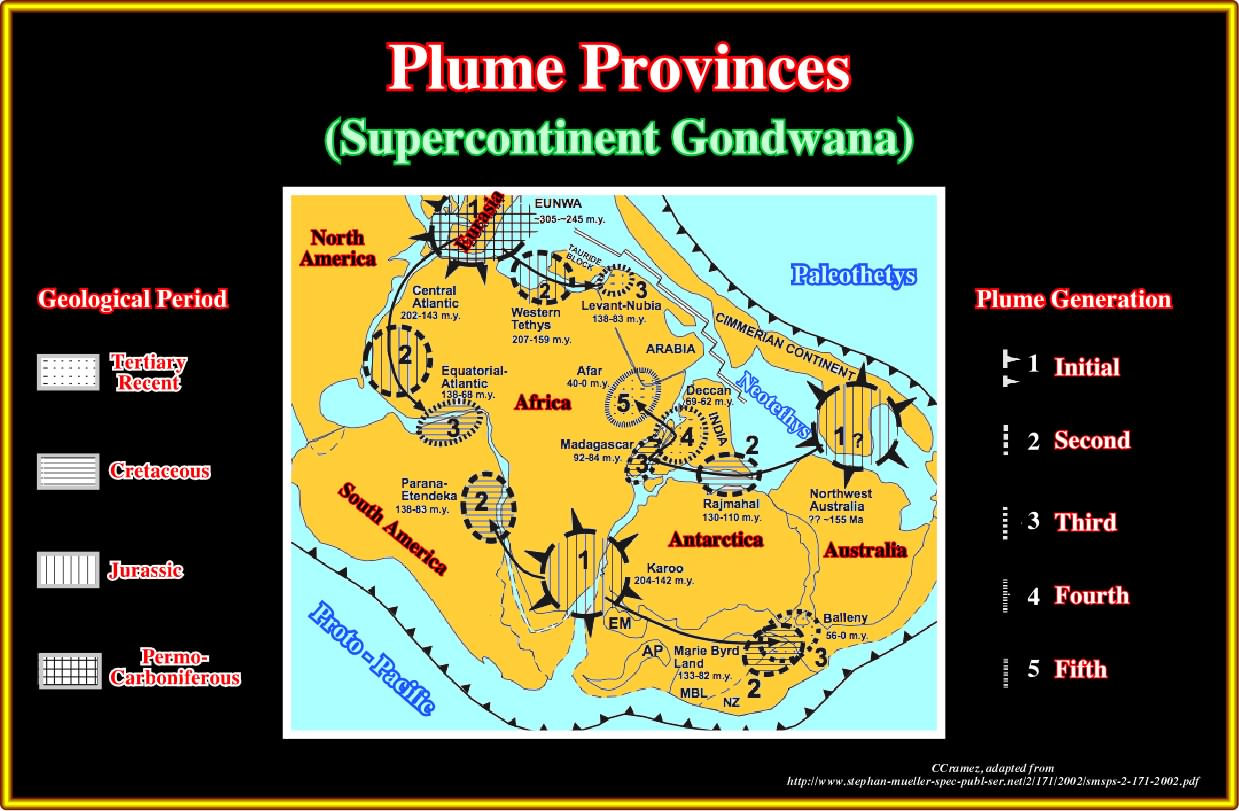
Plate A60.03- At least five plume provinces generation can be taken into account within the Gondwana supercontinent. As first generation three major plumes can be considered: South Eurasia (305-245 Ma), Karoo (204-143 Ma) and Northwest Australia (?-155 Ma). Central Atlantic (202-143 Ma), Parana-Etandeka (138-83 Ma), Mary Byrd Land (133-82 Ma), Rajmahal (130.110 Ma) and Western Tethys (207-150 Ma) are considered plume provinces of second generation. Equatorial Atlantic (138- 58 Ma), Balleny (50-0 Ma), Madagascar (92-84 Ma) and Levant-Nubia (138-83 Ma) are plume provinces of third generation, while Deccan (69-62 Ma) and Afar (40-0 Ma) are considered, respectively, as fourth and fifth generation.
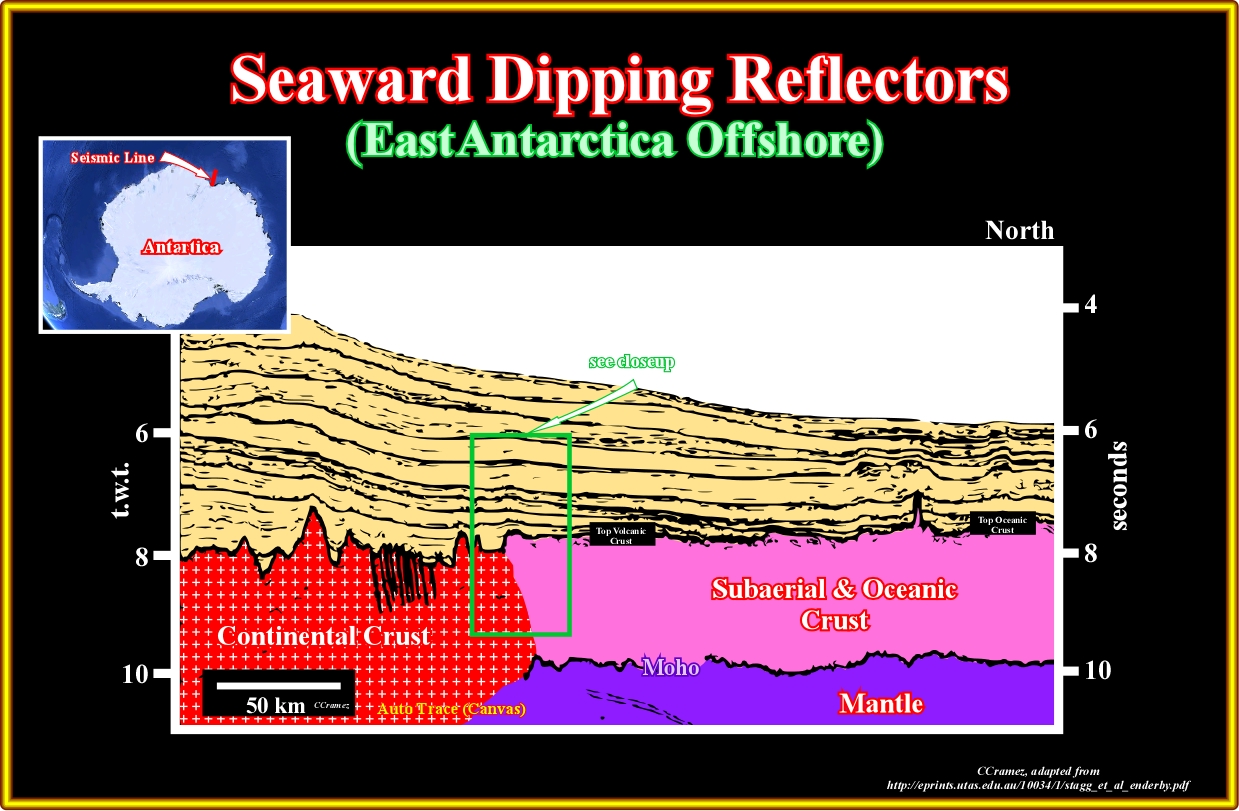
Plate A61.01- On this tentative interpretation of a seismic line of the North Antarctica offshore, seaward dipping reflectors interpreted as subaerial lava flows are likely on the top of the volcanic crust near the continental crust. The close-up illustrated in the next plate strongly corroborate such a conjecture.
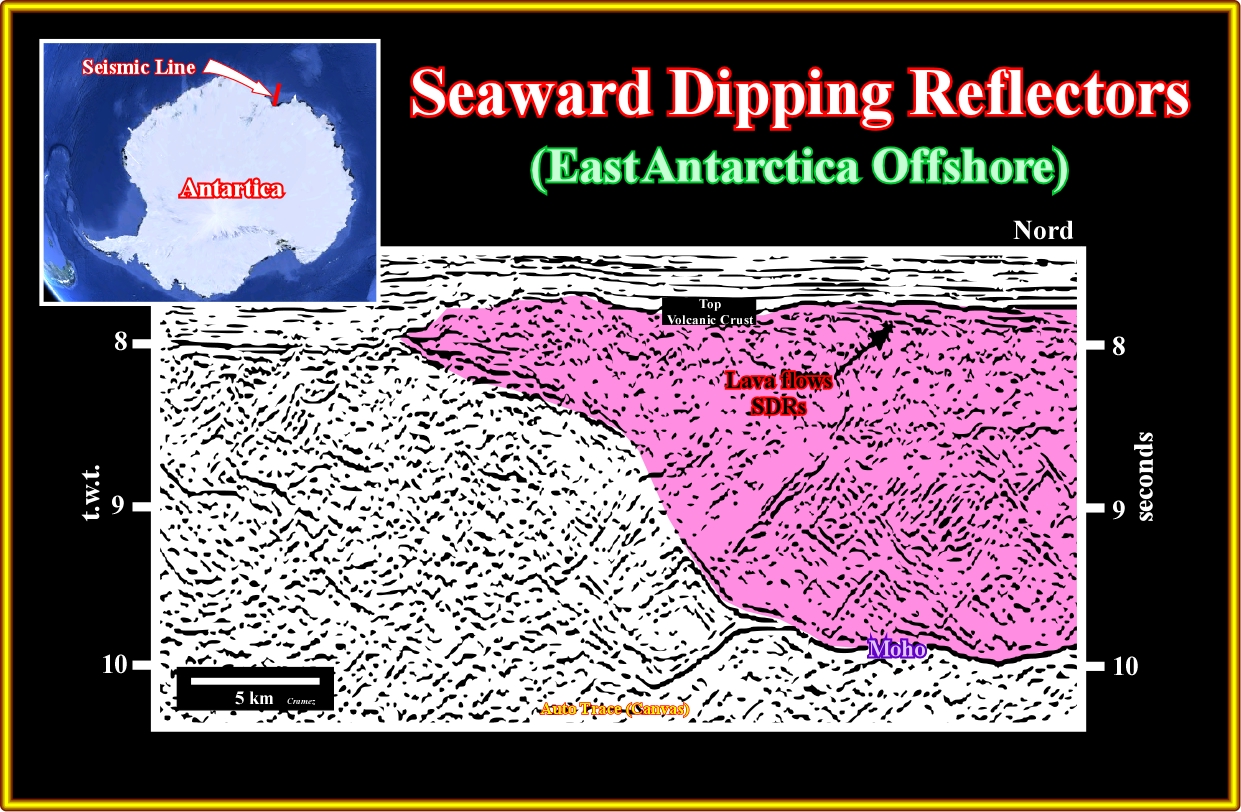
Plate A61.02- In this close-up of the previous seismic line, the seaward dip of the uppermost reflectors of the volcanic crust, as well as the seaward thickening of the interval between successive reflectors corroborates the conjecture advanced in the previous plate, that is to say, the high probability of presence of subaerial lava flowing away of the spreading centres responsible of the oceanization of the new formed Atlantic-type margin.
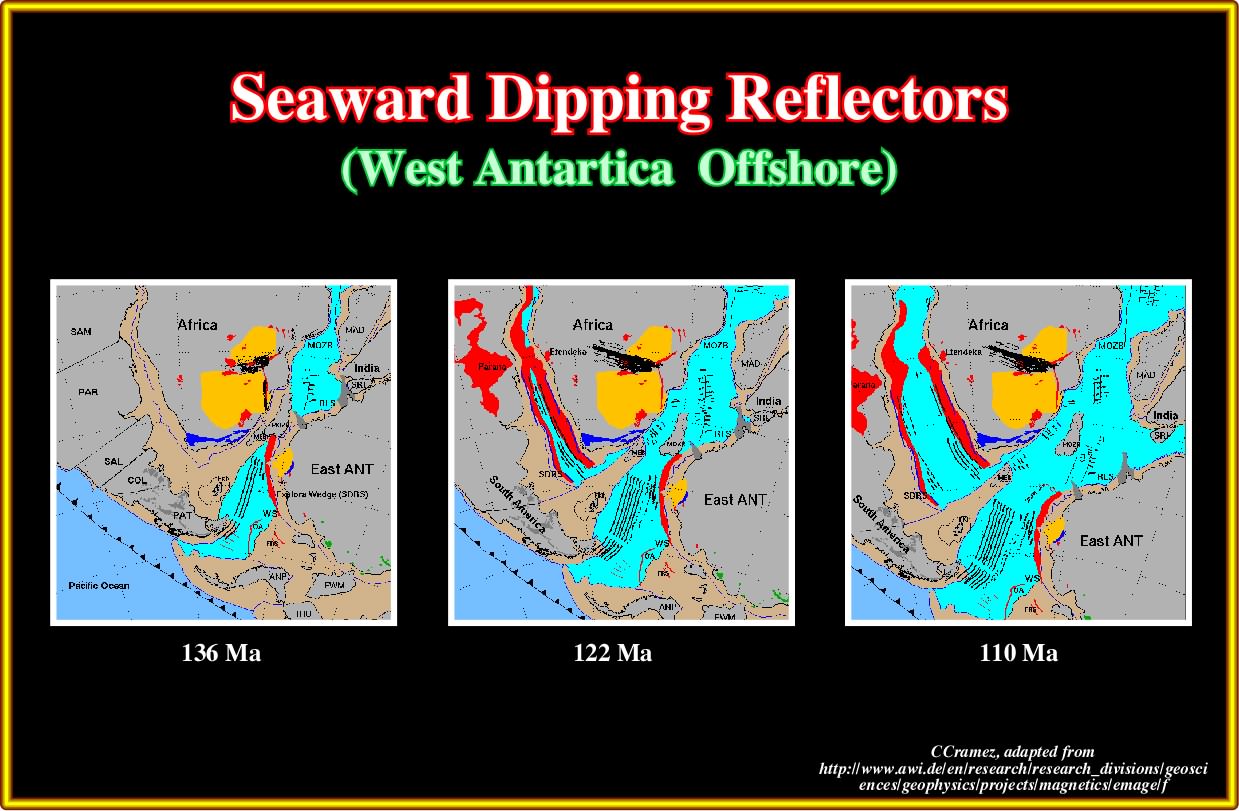
Plate A61.03- On these geological reconstitutions it is easily to predict the areas where subaerial lava flows (seaward dipping reflectors), associated with the breakup of the Gondwana, are likely recognized on well oriented seismic lines, that is to say, seismic lines shot perpendicularly to the continental oceanic boundary.
to continue press
next
Send E-mail to carloscramez@gmail.com with questions or comments about these notes (Altlantic-type Divergent Continental Margins).
Copyright © 2012 CCramez
Last modification:July, 2014